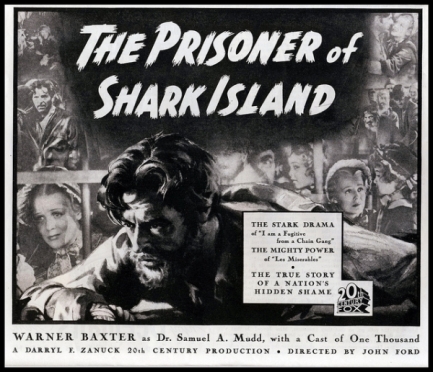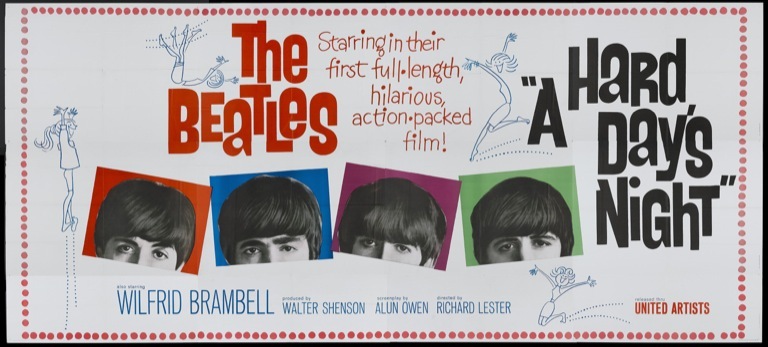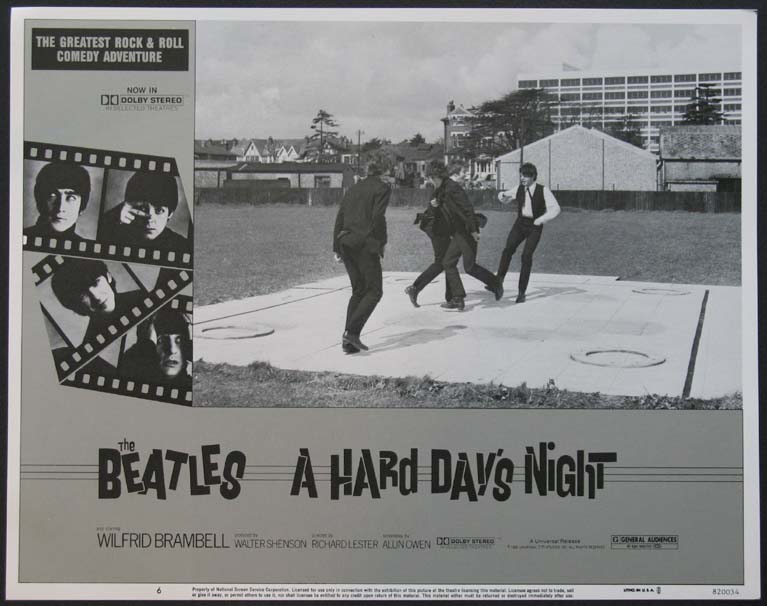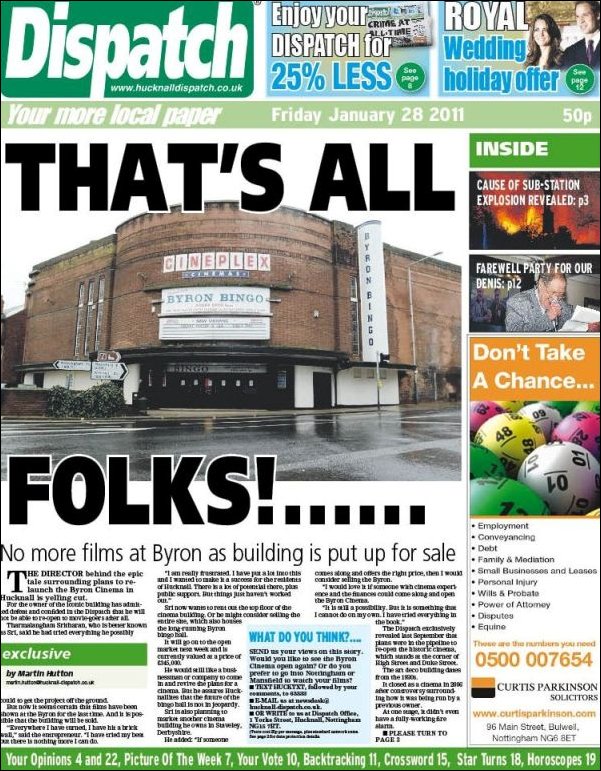The Byron Cinema - History
Home Page / Portland Stone / Art Deco Home / Hucknall Cinemas / Byron Film Listings / 1936 / Souvenir Programme

HISTORY OF THE BYRON CINEMA IN HUCKNALL
Free History .pdf download here
The Byron Cinema opened its doors to the general public on Monday, 2nd November 1936. Two films were chosen to generate interest across all age groups in that first week. From Monday through to Wednesday Shirley Temple (‘glorious as a rainbow’) delighted as ‘The Littlest Rebel’ (1935). For visitors on Thursday through to Saturday Errol Flynn and Olivia de Havilland took centre stage in ‘Captain Blood’ (1935) a swashbuckling saga to out-swashbuckle them all!

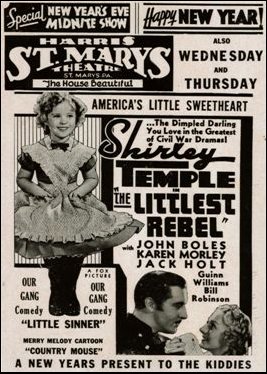
Film Poster for 'The Littlest Rebel' and a typical magazine advert from the United States of the period which may also have been the format seen here

Shirley Temple bidding farewell to the year 1936
A DEATH IS ANNOUNCED
The death of Shirley Temple was announced on Tuesday, 11th February 2014 - a fitting tribute has been paid to the tiny superstar in the Daily Mail (12.02.2014)
Wholesome: Shirley Temple, pictured left in 1933 and right in 1934, got her big break starring in the film Stand Up An Cheer when she was just five-year-old - pictures copyright of Getty Images


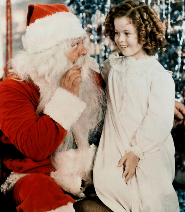
"I stopped believing in Santa Claus when I was six. Mother took me to see him in a department store and he asked for my autograph". Shirley Temple
Location Location Location
On Wednesday, 19th February 1930 the 'ideal site for a cinema in Hucknall' was advertised in The Nottingham Evening Post - it states that the location is on 'good frontage' on the main road and 'cheap.' It was to be a further six years before the cinema became a reality.
At the time, as can be seen from the advertisement as found in the Hucknall Dispatch of Thursday 29th October 1936 and reproduced by the Hucknall Torkard Times, the status of the newly opened building was elevated to ‘The Byron Super Cinema’. The Byron was by no means the only cinema in Hucknall at the time – it shared entertainment time with the Scala (less than half a mile away) and superseded the Empire on Vine Terrace which was turned into a dance hall.
The Nottingham Evening Post previewed the Byron Cinema on Wednesday, 20th December, 1935.
As previewed on the front page of The Nottingham Evening Post on Wednesday, 20th November 1935 courtesy of the British Newspaper Archive
The description of the building states that the elevations will be carried out in light coloured 'faence', which is misspelled and should read 'faience' meaning 'glazed earthenware decorated with opaque colours'. It is a term I am familiar with and always think of the Odeons when imagining this particular terminology. Some examples below show how the 'cladding' could have looked on the Byron Cinema.

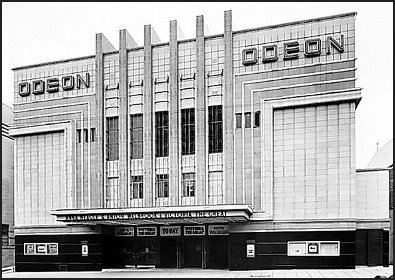
From left to right Odeons at Birmingham in the West Midlands and East Sussex
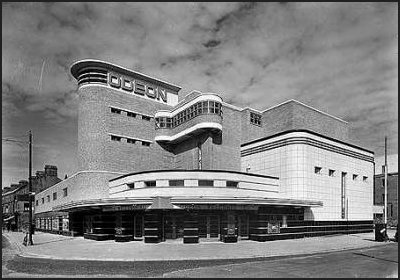
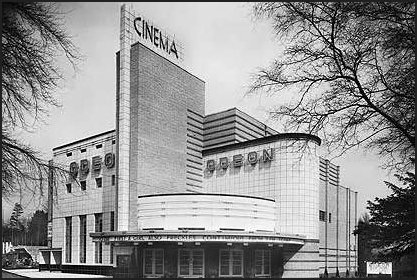
From left to right Odeons at Morecambe in Lancashire and Sutton Coldfield - more about 1930s Cinemas here
The Hucknall Dispatch carried an article describing the events of the opening itself and the forthcoming week of events:
Headed ‘”Byron” Cinema at Hucknall’ the article continues ‘ The new Byron Cinema opened its doors on Monday afternoon, when there was a special performance for invited guests, who were also served with tea and sandwiches by the management.
The consensus of opinion was that it is a delightful house of rest and amusement, the seating being conducive to the utmost comfort, whilst the projection was without fault for the first time so perfect has the art become in these days. This comes with installing the best, and indicates the spirit of the management that Hucknall shall be provided with all that is best in the realm of pictures. Each patron was given a souvenir programme and on leaving people were queuing for the first public performances, the house being crowded. An appeal was has been made 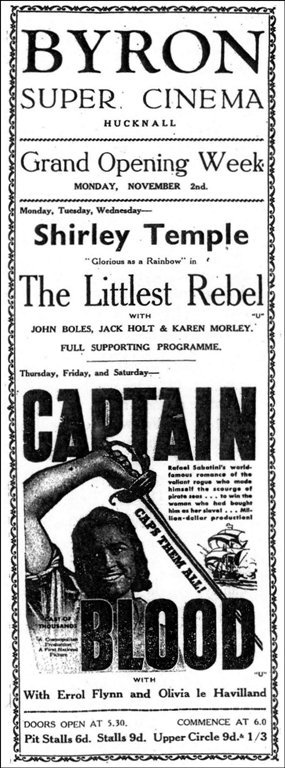 to Mr. H Pryce-Davis, the manager, on behalf of the old-age pensioners of Hucknall. This matter was placed before Mr. R. L. Kemp, managing director who readily agreed that the old people should be admitted to the sixpenny seats at half-price on Saturday afternoons at 2 o’clock. Rafael Sabatini’s famous and colourful story of romance and adventure “Captain Blood” which will be shown at the Byron Theatre to-night, has been filmed on a lavish scale, at a cost of many thousand dollars. An entire year elapsed from the starting of the work on the screen play to the time the picture came out of the cutting room ready for showing, The story opens during the period when the Duke of Monmouth was leading an abortive rebellion against King James II. Dr Peter Blood runs afoul of the soldiery and soon thereafter finds himself a slave in the West Indies and later the captain of a pirate ship. His calm effrontery wins the attention and then the hatred and finally the love of the beautiful young noblewoman. This vigorous young daredevil puts down mutinies and scuttles ships with desperate coolness, saving his warmth for the ardour of his love. In the cast are Errol Flynn, Olivia de Havilland, Basil Rathbone, Lionel Atwill and Guy Kibbee.
to Mr. H Pryce-Davis, the manager, on behalf of the old-age pensioners of Hucknall. This matter was placed before Mr. R. L. Kemp, managing director who readily agreed that the old people should be admitted to the sixpenny seats at half-price on Saturday afternoons at 2 o’clock. Rafael Sabatini’s famous and colourful story of romance and adventure “Captain Blood” which will be shown at the Byron Theatre to-night, has been filmed on a lavish scale, at a cost of many thousand dollars. An entire year elapsed from the starting of the work on the screen play to the time the picture came out of the cutting room ready for showing, The story opens during the period when the Duke of Monmouth was leading an abortive rebellion against King James II. Dr Peter Blood runs afoul of the soldiery and soon thereafter finds himself a slave in the West Indies and later the captain of a pirate ship. His calm effrontery wins the attention and then the hatred and finally the love of the beautiful young noblewoman. This vigorous young daredevil puts down mutinies and scuttles ships with desperate coolness, saving his warmth for the ardour of his love. In the cast are Errol Flynn, Olivia de Havilland, Basil Rathbone, Lionel Atwill and Guy Kibbee.
Quick death on the gallows would have been a mercy for him. He lived to die a thousand times! Revealing for the first time in all its vivid horror and brutality the shocking story of a nation’s hidden shame, “The Prisoner of Shark Island” (1936) comes on Monday. Its hero is a gaunt figure who looms out of the pages of American History. Dr Samuel Alexander Mudd, martyred by a nation’s frenzy for his innocent deed of mercy. With Warner Baxter starred in the leading role, the picture tells the story of this gentle Maryland physician who was trapped with Lincoln’s murderers and who spent years in a living hell for a crime he had never committed.
To protect an orphaned kid, Buck Jones moves like greased lightning. fights like fury and rides like a whirlwind to wipe the sneers from the faces of the townsfolk and vindicate the fairy of a youngster who believes in him in “The Cowboy and the Kid” (1936) the supporting film.”
The article is written in a generic manner (ahead of the opening) as it is in the same edition as the advert for the Byron Super Cinema dated 29th October 1936.
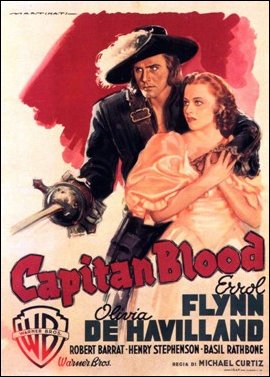
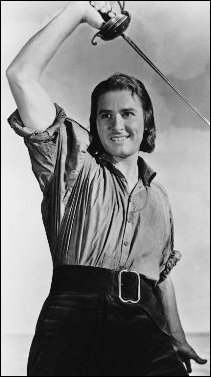
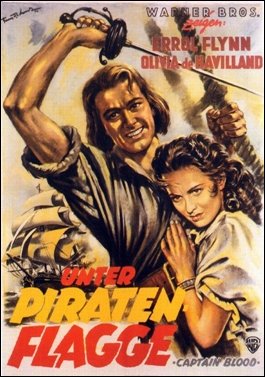
The colour film poster does not use the studio shot of Errol Flynn as seen above although the designers of the poster for the cinema chose to use it - a romanticised version of the pose is also used in foreign-language versions of the film.
Both films chosen for the second week were right up-to-the-minute 1936 productions and even if not quite starring quite such impactful actors as Shirley Temple, Errol Flynn and Olivia de Havilland the subject matters would be guaranteed to appeal to all generations. 'The Cowboy and the Kid' was part of a larger franchise which incorporated comic-books as well as spawning a series of films.
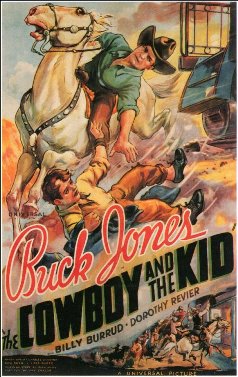
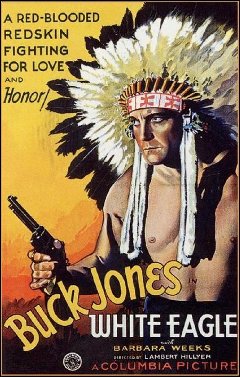
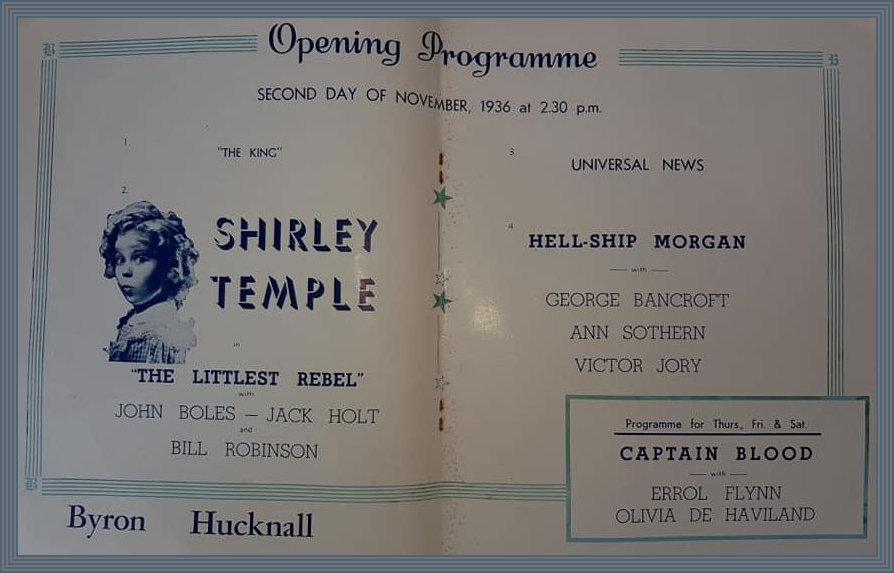
The centrepiece of the Opening Night Special Commemorative Souvenir Programme for the inauguration of the Hucknall Byron Super Cinema
ARCHITECTURE, SITE AND INTERIOR COMFORT
In recent years, a copy of the Souvenir Programme mentioned in the preceding article from the Hucknall Dispatch has been discovered. It contains information that until now has not always been readily available and fills many of the gaps in the cinemas’ provenance.
It has always been known that the architect was Alfred J. Thraves and that he designed several cinemas of which only five (structures) survive. Of those only one, the Majestic in Retford is still functioning as a cinema. The Byron is still recognisable but is run only as a bingo hall. (The full tally can be found here:
The leaflet is first mentioned in the authoritative article of 29th October 1936 found in the Hucknall Dispatch. The front displayed a beautiful artists impression of how the new cinema would look. A previous attempt to construct a cinema had been thwarted by the 'crisis of 1931' (known as 'The Tragic Year' which led to the onslaught of the Depression) which hit Hucknall, in particular, very badly. To make up for that great disappointment and to revitalise Hucknall at a time when it was sorely needed, the Super Cinema became a reality and not only would it be 'super' because of its size but also because improvements in cinema were so great that a much bigger structure would be required to house the technology. (Unlike the Rex in Berkhamsted where the technicians had to gain access to the Projection Room via an external staircase come rain or shine to accommodate the new changes! Since its refurbishment in the 21st century, the Rex now has indoor access).
Alfred Thraves, like many other architects of the 1930s loved Portland Stone which can be found in buildings everywhere running the length and breadth of the UK. Having secured the site, and ensuring that no advertising opportunity was missed, he set to work designing the cinema that would take prime position in the town. A notice board, on a barren site at the corner of High Street and Duke Street announced “Site for a Super Cinema! The new cinema to be styled the ‘Byron’ – has been erected by Messrs. Simon of West Bridgford, to plans prepared by Mr. Thraves. There is a noble entrance on the corner and exists to High Street and Duke Street. The building will rank amongst the best in the county”. I wonder what that announcement looked like? More information emerging from the souvenir programme tells us that ‘The elevation is carried out in Sand stock Bricks and Portland Stone in the modern style with a striking glass and metal turret which is illuminated at night. A feature of the exterior which will be much appreciated is the canopy which is provided to protect our patrons during bad weather.”
Alfred Thraves held true to the spectacular illustration which graced the front of the Souvenir Programme but only an aerial shot of the cinema reveals its astonishing and striking presence in the town.
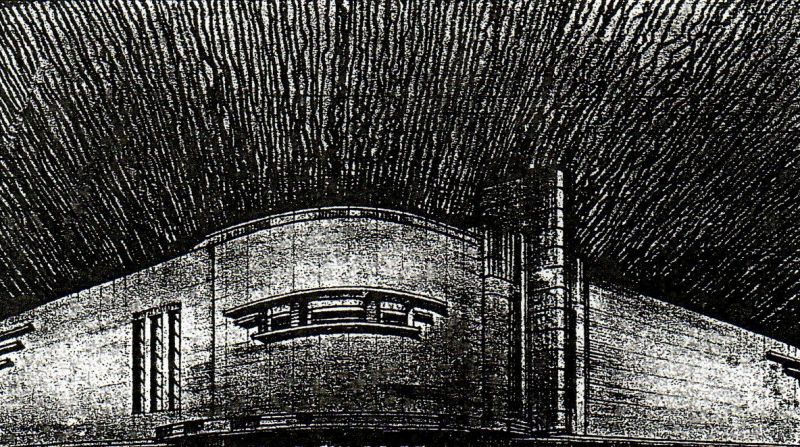
The architects vision of the Byron Super Cinema
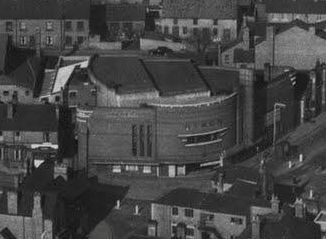
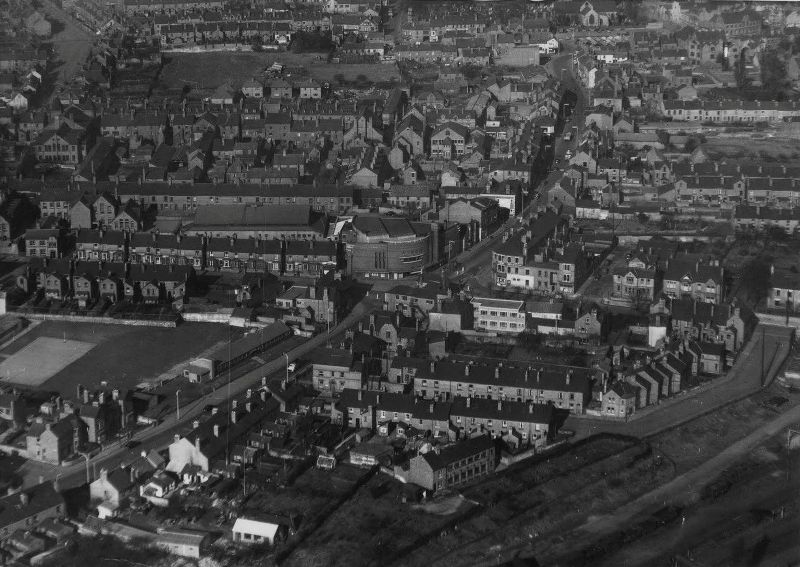
The Byron, in full splendour, situated on the corner of the High Street at about the time of its opening
The souvenir programme goes on to tell us that 'The building throughout is of fireproof construction. Exits and toilet accommodation is far in excess of stipulations and staff quarters are models of convenience. The picture itself will be perfection both as regards visibility and sound. Correct acoustics being the great essential for Talkies.'


The advert boasts 'Talking Pictures at their Best' - and only the best was projected for the Byron and the nearby Palace in Beeston, Nottinghamshire!
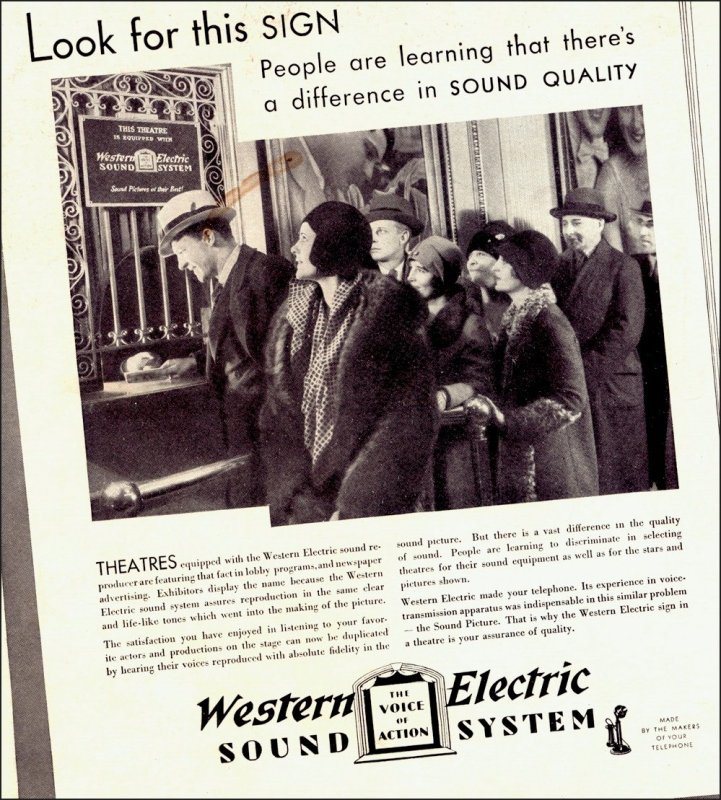
Patrons being actively encouraged to demand better sound quality,
Mr. R L Kemp, Managing Director of United Entertainments Ltd (of which the Byron is just the latest addition) is quoted as follows "The Byron Projection Room fills us with great pride and the management cordially invite any of our patrons who so desire to view the projection room. 'Wide Range' is the latest improvement developed by Western Electric engineers. It will be remembered that Western Electric were the pioneers of talking pictures and Wide Range is their latest scientific achievement. It is therefore with pride and pleasure that the Byron Cinema present talking pictures under conditions that will equal the finest in America and Europe.
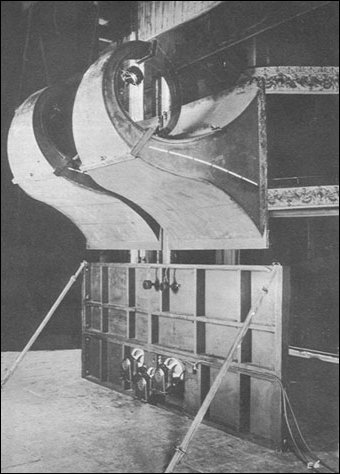
A complete Wide range system with three TA4151, two 597A Bosquet tweeters and two 15A horns with 555 drivers on a large(!) W.E. baffle. The baffle is probably 11′ x 8′ for a scale reference. Source Twittering Machines
With a total seating of 1,250 the Byron claimed the greatest capacity for entertainment in one sitting. The souvenir programme recalls "Furnishing and fabrics have been specially designed and seating throughout is most roomy - ample knee room being allowed for and every patron will have an uninterrupted view of the screen." That screen was housed in the ample proscenium whose dimensions were 33 feet wide and 16 feet deep.
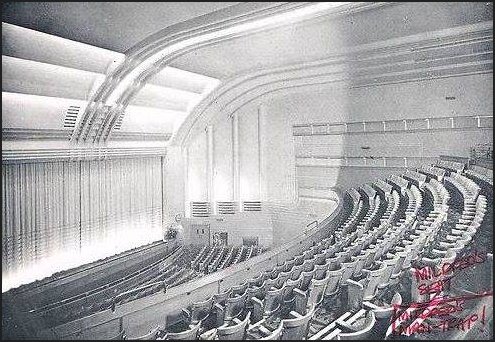
A postcard of the Muswell Hill Odeon dated 1936 - judging by available groundplans, this is possibly how the Byron looked when it opened to great acclaim for its rich and plush carpets and seats and luxurious grandeur.
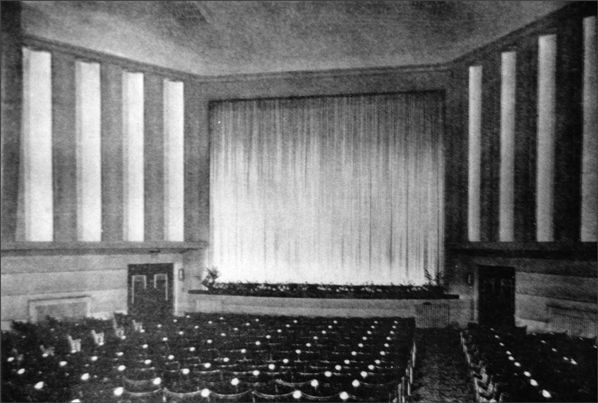
Recently an image of the interior of the Hucknall Byron Super Cinema was kindly provided by Cinema Theatre Association Archive and is shown above - many favourable comparisons to the Muswell Hill Odeon can be found.
The last images of the interior that are available for viewing were found on Flickr and can be found here - they date from the late 1990s and first decade of the 21st century. They certainly evoke the plushness so avidly described previously.
Prices were tiered to reflect seating location - the stalls (no longer in existence) were priced sixpence and ninepence (2½d = 1p) and the circle commanded prices of a shilling (12d) or one shilling and threepence (15d)
END OF DAY 1
And then came the 1939 - 45 WAR
THE WAR YEARS
This section will be on-going for the time being as there is not too much information immediately available. What is known is that the Byron did continue to function as a cinema disseminating information and propaganda to keep up the spirits of those who remained behind. It will also have offered respite to loved ones coming home on leave. Recent information found in the editions held by the British Newspaper Archive shows that there was constant and patriotic activity occurring at the Byron.
In March 1942 Warship week was in full swing and once again the Byron found itself in the headlines of the front page of the Nottingham Evening Post.
As can be seen the navy personnel and members of the Council and the nursing/British Red Cross corps were in evidence. The accompanying article is reproduced below.
The content of the articles is very graphic and 'no holds barred' tactics pronounced.
I was intrigued to see this announcement from the Saturday, 9th January 1943 edition :
An invitation to attend a public meeting at the Byron Cinema entitled "What the Communist Party Stands For" and to be accompanied by 'Russian Films' - 'Battleship Potemkin' perhaps? or one of my favourites by Sergei Eisenstein ''Ivan the Terrible'.
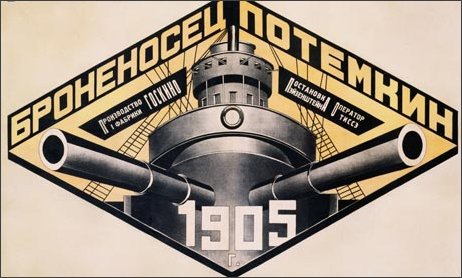
And from Monday, 22nd of March 1943 we learn that a concert in aid of the Notts Services and Prisoners' of War Comforts fund was held on Sunday, 21st March at the Byron.
THE SALVAGE COMPETITION
Thursday, 13th April 1944
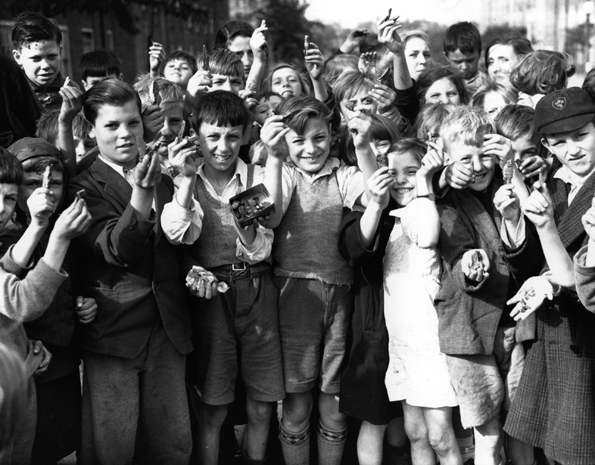
East End kids with their collected scrap for the war effort but the kids of 'Every town' and Hucknall would have looked very similar - thank you to the BBC for the image.
Eleven hundred 'kiddies' were entertained at the Byron Cinema in connection with the Salvage Competition. Councillor Gliding presented a shield to National Schools and certificates to named individuals.
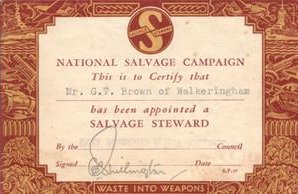
This was a national initiative and even the BBC got in on the act : "The war effort - Everyone was asked to help win the war, by making extra efforts and working harder on the 'home front'. Children saved pennies, collected scrap metal and food waste, and knitted woolly hats for soldiers and refugees. BBC Children's Hour ran a scrap-collecting competition. The winners collected 9 tons of scrap."
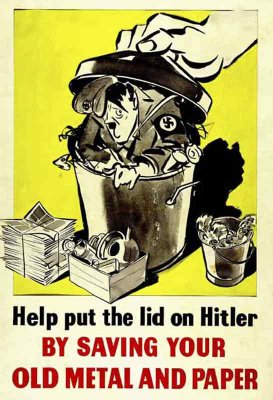
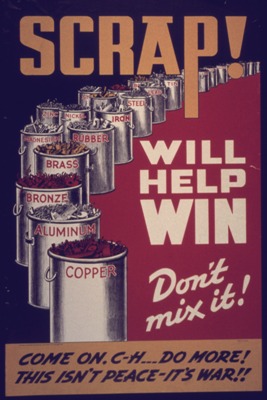
Posters like these will have kept the initiative to collect scrap going
Keeping cinemas open was another national initiative. It is interesting to note that other Art Deco establishments were used for alternative purposes. The Nottingham Ice Stadium was transformed into an 'arsenal storage facility', the Midland Hotel in Morecambe became a hospital and the Ocean Hotel in Saltdean was handed over to the Fire Brigade for the duration.
Recently, a memory from Edith Chamberlain, now in her 90s gives a personal snapshot of her war experience at the Byron : Now in her nineties, Edith Chamberlain remembered being a Byron usherette during the War. “When the air-raid siren on the cinema roof sounded,” she said, “we could’t go home. Some customers walked out, but we had to stay behind to look after the rest.” Edith stood no nonsense from noisy cinema goers and said: “We’d shine our torch light on them, and say ‘If you’re not quiet – outside!’” When the film had finished and the audience went home, the usherettes had to put all the seats back up, and check for lost property. Said Edith: “I found plenty of glasses and umbrellas, but no money – never any money.” Source - Hucknall Dispatch 13th June 2014

World War 2: War workers queuing for a midnight show at the cinema. circa 1940. Photo: Three Lions/Getty Images
From the Daily Telegraph dated 9th September 1939 :
Audiences in the morning were not large. They rarely are, even in normal times; and on Saturday many people were not aware of the reopening. In the evening and again last night attendances were large enough to prove the wisdom of the decision to lift the ban. When programmes ended at 10 pm people trooped out cheerfully, agreeing that entertainment in these dull, anxious evenings was cheap at the cost of a little stumbling and minor collisions in the dark. Twenty cinemas were open at Brighton and Hove. Apt. W. J. Hutchins on, Chief Constable of Brighton, has kept in touch with the Sussex branch of the Cinematograph Exhibitors’ Association and a working arrangement promising entertainment with reasonable safety has been evolved. On an air raid signal being given programmes will stop for five minutes, and audiences will be told where the nearest shelter is. Those who wish to leave will do so, and the rest will be able to see the continuation of the films.

An advert for two films being shown at the Byron from 29th June 1939 as war clouds were looming.
Refund / Leave cinema / Warning 2 / War Years Ref: /
POST-WAR 1946 - 1967 - A CHANGE OF FORTUNE
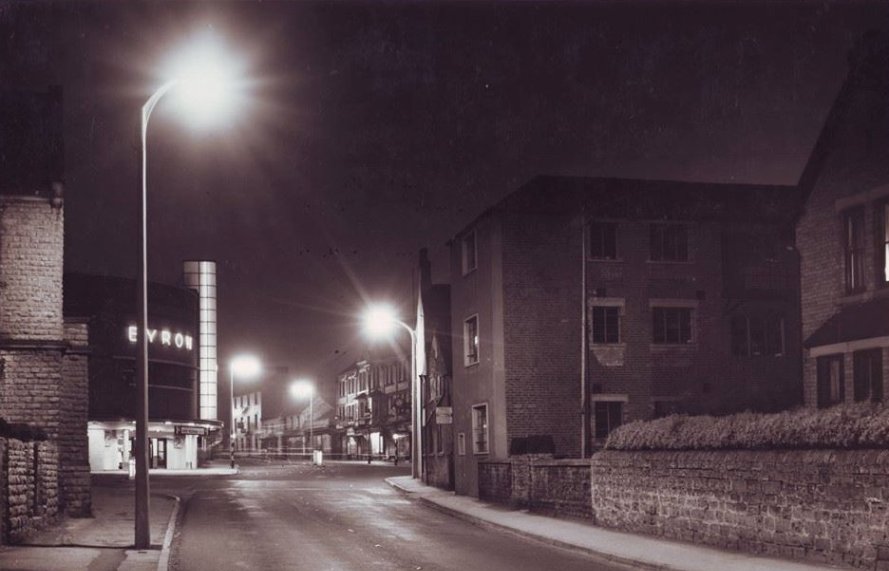
A spectacular Night view approaching a lit up Byron - the lamp post lights almost look as if they have been enhanced. Timeframe is uncertain as there are conflicting clues - concrete lampposts/bollards hint at anywhere between late 50s-mid-60s. The cats eyes could have been there from the 1930s and the Belisha Beacon/Pelican Crossing also give a wide span from 1930-70s. Happily the Tower is still capable of being illuminated without any reference to the cinema sharing the premises with Bingo Nights.
General Timeline Snippets 1946-1967
1946
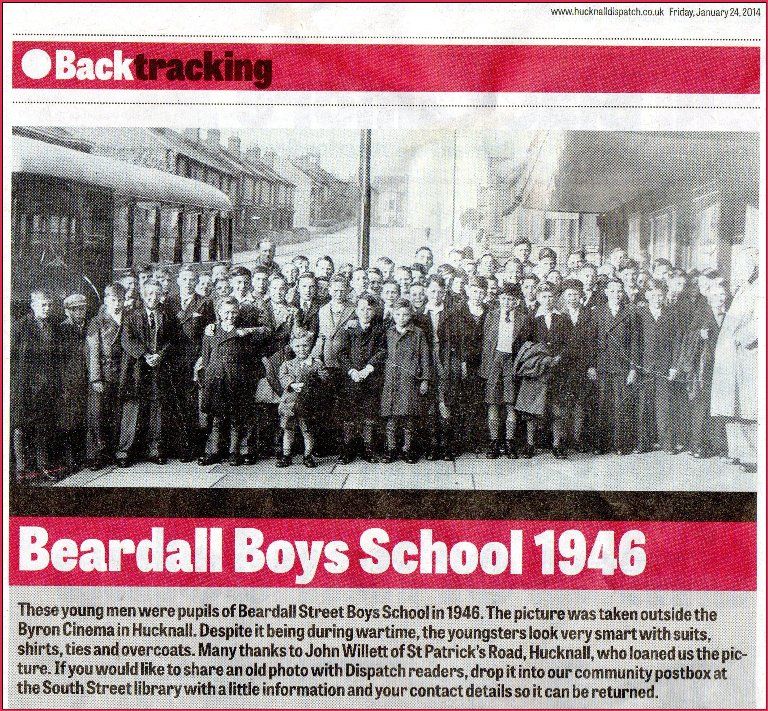
With thanks to the Hucknall Dispatch (Friday, 24th January 2014) and John Wallet

This seems to have resurfaced on either Friday, 9th/16th March 2014 as the '50 years ago' date was given as 13th March 1964
1948
The Nottingham Evening Post dated Saturday, July 31st 1948 reports how the people of Hucknall rallied around to help former Byron Cinema Manager, Mr F N Bur bury when he was told that he would never walk again.
The article refers to the fund-raising that Mr Bur bury initiated during the war years to supply 'comforts' to local Service personnel. Prior to that he had worked tirelessly to raise funds for the disadvantaged children in the City of Nottingham. In addition to the 'comforts' for service personnel, Mr Bur bury also campaigned to raise large sums for the Services charities including the British Red Cross, sick nursing and cripples. His final 'big effort' was in 1947 when he raised funds specifically for the dependents of the White haven and Ann field Plain colliery disaster funds. Mr Bur bury was obviously a man who did not discriminate judging by the eclectic mix of causes he embraced.
Sadly, he was only to live a little while longer before the Nottingham Evening Post announced his death on Tuesday, 28th September 2014 and published his obituary which briefly linked him to the Byron cinema.
Films Showing during this period (additional information here)
The 1960s
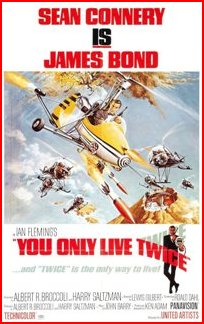
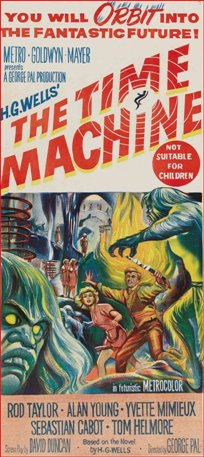
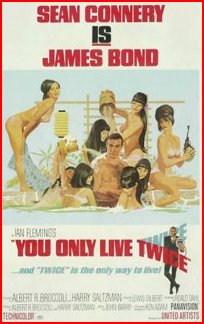
46 years ago (31st of December 1967) the Byron Cinema opens as a split entertainment centre with the cinema in the balcony area and Bingo Hall in the former stalls area with the classic Bond film 'You Only Live Twice' running every night for a fortnight! The two posters show the most popular aspect of the film - James Bond - Action Man and James Bond - Lady Killer - I wonder which poster featured in Hucknall?
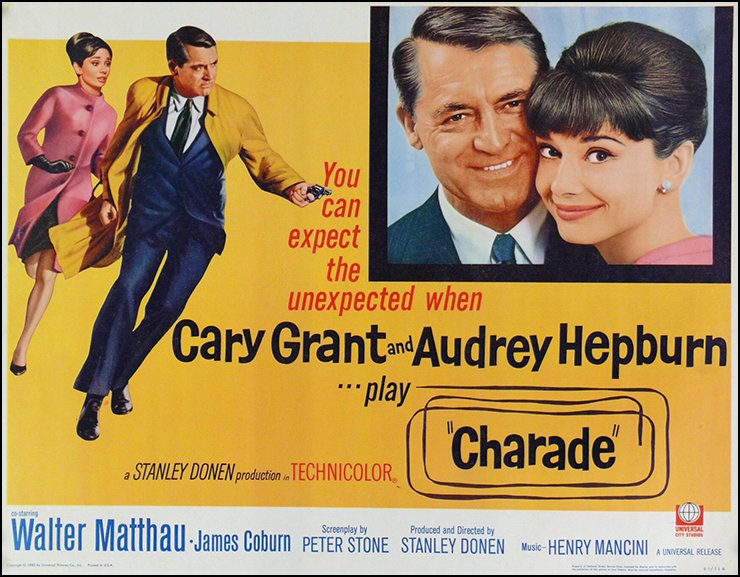
50 years ago (18th September 1964) 'A fast moving comedy thriller with a Paris setting. 'Charade', starring Audrey Hepburn and Cary Grant, can be seen at Hucknall's Byron Cinema.' (Source Hucknall Dispatch 19.09.2014) - The Story : Cary Grant and Audrey Hepburn star in this stylish comedy-thriller directed by Stanley Don en, very much in a Hitchcock vein. Grant plays Peter Joshua, who meets Reggae Lam pert (Hepburn) in Paris and later offers to help her when she discovers that her husband has been murdered. After the funeral, Reggae is summoned to the embassy and warned by agent/friend Bartholomew (Walter Matthew) that her late husband helped steal 250,000 dollars during the war and that the rest of the gang is after the money as well. When three of the men who attended her husband's funeral begin to harass her, Reggae goes to Joshua for help, at which time Joshua confesses that his name is actually Alexander Dole, the brother of a fourth accomplice in the gold theft. The three men from the funeral are revealed to be the three other accomplices in the crime, and though she knows next to nothing of the heist, Reggae is caught in a ring of suspense as she is followed by the shadowy trio, all after the money. Apparently, the only person she can trust is Joshua/Dole -- until Bartholomew tells Reggae that the fourth accomplice had no brother, and Joshua/Dole reveals that he is, in fact, a crook named Adam Can field. Now Reggae doesn't know where to turn. The musical score by Johnny Mercer and Henry Mancini was nominated for an Academy Award.~ (Source: Paul Burner, All Movie Guide)
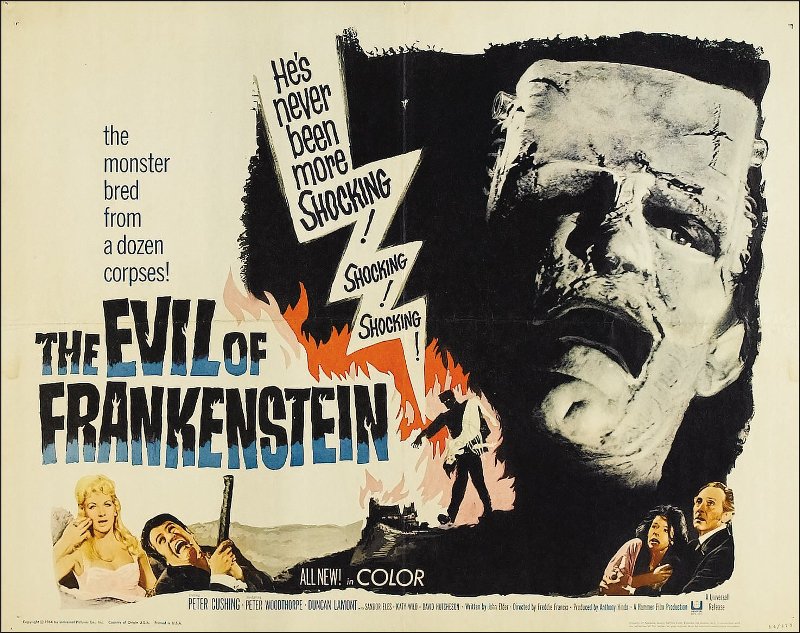
50 years ago (11th September 1964) Peter Cushing stars in a shock thriller, 'The Evil of Frankenstein', showing at the BYRON CINEMA in Hucknall. (Source Hucknall Dispatch 12.09.2014) - The Story : Classic horror starring Peter Cushing. Penniless, Baron Frankenstein (Cushing), accompanied by his eager assistant Hans (Sand or Else), arrives at his family castle near the town of Karl st a ad, vowing to continue his experiments in the creation of life. Fortuitously finding the creature he was previously working on, he brings it back to a semblance of life but requires the services of a mesmerist, Sultan (Peter Radiothermy), to successfully animate it. The greedy and vengeful Sultan secretly sends the monster into town to steal gold and 'punish' the burgomaster and the chief of police, which acts lead to a violent confrontation between the baron and the townspeople. (Source: Amazon retailers)
50 years ago (4th September 1964) 'A Hard Day's Night', starring The Beatles, is to complete a six-day run at the BYRON CINEMA in Hucknall. (Source Hucknall Dispatch 05.09.2014) - The Story : Meet the Beatles! Just one month after they exploded onto the U.S. scene with their Ed Sullivan Show appearance, John, Paul, George, and Ringo began working on a project that would bring their revolutionary talent to the big screen. A Hard Day's Night, in which the bandmates play wily, exuberant versions of themselves, captured the astonishing moment when they officially became the singular, irreverent idols of their generation and changed music forever. Directed with raucous, anything-goes verve by Richard Lester and featuring a slew of iconic pop anthems, including the title track, "Can't Buy Me Love," "I Should Have Known Better," and "If I Fell," A Hard Day's Night, which reconceived the movie musical and exerted an incalculable influence on the music video, is one of the most deliriously entertaining movies of all time. (Source : IMDB)
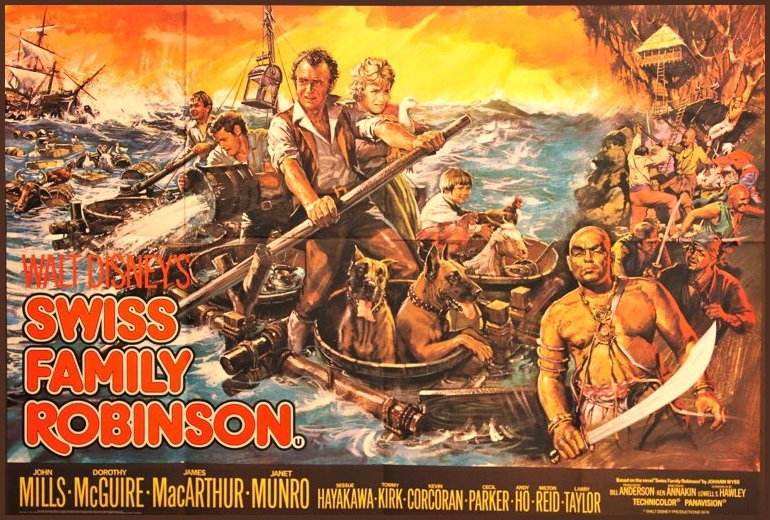
50 years ago (16th August 1964) - Showing at the BYRON CINEMA in Hucknall is ‘Swiss Family Robinson’, co-starring John Mills and Dorothy Mucor. (Source Hucknall Dispatch 05.08.2014) - The Story : A family on their way to New Guinea is chased by pirates into a storm. The captain and crew abandon the ship leaving the family shipwrecked off an uninhabited island. Father (John Mills) and his two eldest sons Fritz and Ernest (Tommy Kirk and James Mac Arthur) salvage as much as they can from the wreck including livestock, tools, and even an organ. As they gather what can be removed from the ship, the pirates return and begin shooting at the ship. Fritz and Ernest begin readying the ship's cannon, but they only have one shot. Suddenly, the pirates turn around; Father has put up a flag indicating the ship is under quarantine and that there is Black Death aboard. The three men construct a tree house home on the island while the youngest boy Francis (Kevin Cor cor an) investigates the wildlife and starts an impressive collection of animals including a young elephant, a capuchin monkey and two Great Danes rescued from the ship which they name Duke and Turk. Mother (Dorothy Mucor) prays to be rescued. The boys, particularly Ernest, also build inventions to provide modern amenities to the family such as drawing water and preserving food. Fritz and Ernest head off to explore the island and try to see if anyone else lives on it or if it is connected to any other lands. While at a distant corner of the island, they again spot the pirates who originally drove them into the storm. The pirates have captured another ship and have the ship's captain and cabin boy "Bertie" captives for ransom. Fritz and Ernest rescue Bertie but the captain, Bertie's grandfather, stays behind. The three dodge the pirates and head back to the family's tree house. En route, they discover that Bertie is really Roberta (Janet Monroe) and not a boy at all. The three fend off snakes and hyenas as they head home and even rescue a zebra foal then lead it home. They arrive back at the tree house at Christmas. Father realizes the pirates will try to reclaim her and decides to make a stand against them. Defences are prepared by building boo by-traps and fortifying a rocky outcropping. They blow up the ship's wreckage in an attempt to make it difficult for the pirates to remember where the family went aground. While prepping for the pirate attack, Fritz and Ernest vie for the affections of Roberta. Ernest is more studious and attempts to sway her with his knowledge and intelligence while Fritz, older and not studious, uses his charm and physical attributes to attract her. Fritz and Ernest eventually come to blows over her and are only stopped by the intervention of Father. He declares the next day the first holiday for "New Switzerland" in an attempt to divert everyone. While prepping for the race (everyone has an animal to ride: Francis has the elephant, Ernest the ostrich, Roberta the zebra, the monkey on Duke, etc.), Mother fires the gun to signal the start of the race; the pirates, who are at that time sailing the coast looking for the place they last saw the ship that brought the family to the island, hear the gun and know the family is near. Led by their captain (Say-so Hawkeye), the pirates storm the island. The family manages a brave defense but are sorely pressed. Their defences include pits with a tiger in one pit, rock piles, a log pile and coconut bombs (hollowed out coconuts filled with gunpowder with a fuse), all of which cause problems for the attacking pirates. When the pirate leader waves a white flag the family imagines they have routed the pirates, but the pirates instead are sneaking around the back of the fort. Francis' much-maligned "pirate alarm" is the only thing that warns them of the surprise attack. They begin defending the fortress but are soon down to only a few shots with their muskets. At this critical moment, a ship appears on the horizon captained by Roberta's grandfather (Cecil Parker) and fires its cannons while the retreating pirates are trying to make a desperate escape. The cannon fire hits the pirate ship while the family rejoices. Father, Mother and Francis choose to remain on the island with Duke, Turk and Francis' collection of animals while the Captain notes that Father will likely be recommended as Governor of the new colony. As for the rest of the family, Ernest chooses to return to Europe with the rescuers in order to enrol in a university to continue his studies while Fritz and Roberta plan to marry and make New Switzerland their home. Source Disney Wiki / IMDB Ref. / Swiss Family Robinson was the first wide screen Disney film shot with Panavision lenses. When shooting in widescreen, Disney had nearly always used a matted wide screen or filmed the movie in CinemaScope (Source Disney Wiki)
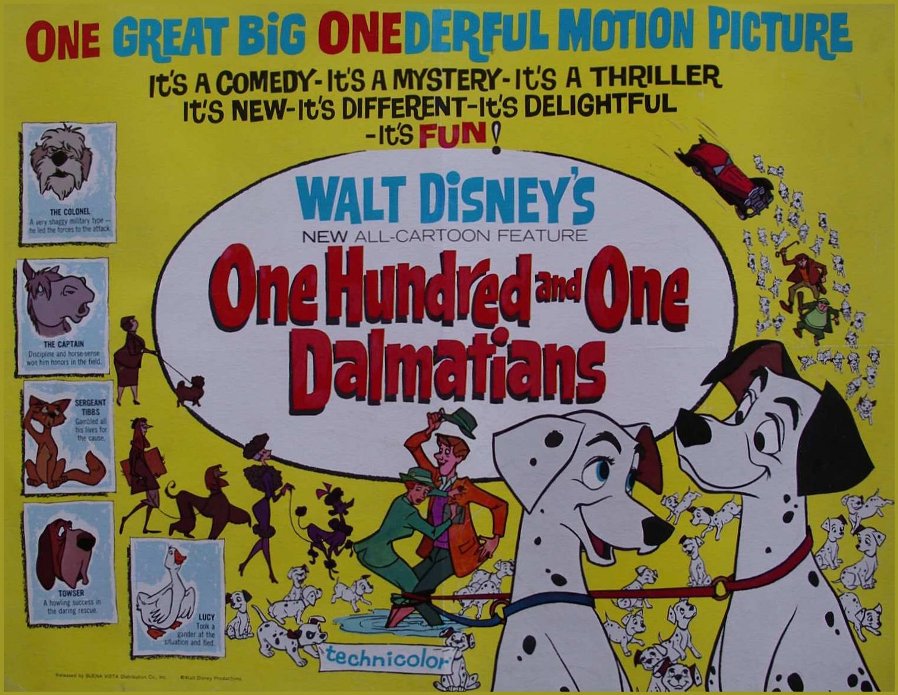
50 years ago (8th August 1964) - Based on the well-read book by Do die Smith, Walt Disney’s ‘101 Dalmatians’is showing at the BYRON CINEMA in Hucknall. (Source Hucknall Dispatch 08.08.2014) - The Story : Full of boundless adventure and boisterous fun, Disney's 17th animated masterpiece is the original film classic starring 101 of the world's most lovable, huggable Dalmatians and their hilariously evil captor, Cruel la De Evil! A charming London neighbourhood is home to Roger and Anita, whose beloved Dalmatians, Pongy and Partido, have become the proud parents of 15 puppies. But when Cruel la and her bumbling henchmen, Horace and Jasper, unexpectedly appear, the pups soon disappear along with every other Dalmatian puppy in town! Now Pongy and Partido must rally their animal friends and use the power of the "Twilight Bark" to find Cruel la's secret hideaway and free the puppies. Featuring the unforgettable toe-tapping song "Cruel la De Evil", 101 Dalmatians is one of the most cherished and sought-after Disney classics of all time and among the last films to bear the personal touch of Walt Disney. Source Disney IMDB
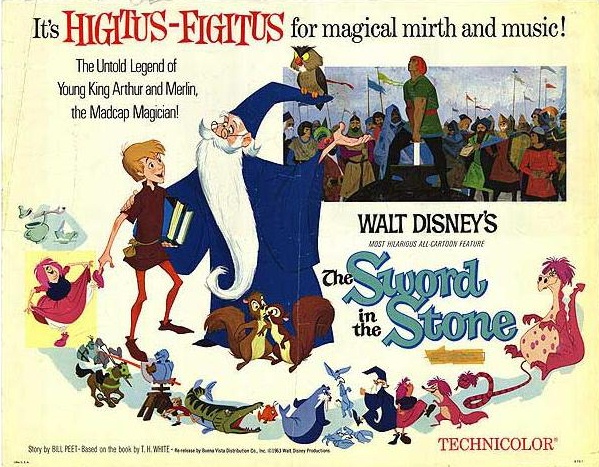
50 years ago (31st July 1964) - Walt Disney’s ‘The Sword in the Stone’, which tells of a boy named Wart who becomes King of England, can be seen at the BYRON CINEMA in Hucknall. (Source Hucknall Dispatch 01.08.2014) - Synopsis: The film begins in England with the death of the king, Ut her Pen dragon. No heir is named, and so England is threatened to be torn apart by war. Miraculously, the mystical "Sword in the Stone" appears in London, with an inscription proclaiming that whomever pulls it out is the rightful King of England. Many try to remove the sword,but none succeed and the sword is soon forgotten. Some years later, Arthur (a.k.a. Wart), a 12-year-old orphan training to be a squire, accompanies his older foster brother Kay on a hunting trip. Wart accidentally prevents Kay from shooting a deer, and goes to retrieve the arrow to make up for his mistake. In the woods, Wart falls into the cottage of Merlin, a powerful wizard. Merlin announces he will be Wart's tutor, packs up and the two return to Wart's home, a castle run by Sir Sector, one of Ut her's knights and Wart's foster father. Sector does not believe in magic, and refuses to allow Merlin to tutor Wart. Merlin creates a blizzard, which persuades Sector to let Merlin stay, albeit in a decrepit old tower with countless leaks. Sector's friend and fellow knight, Sir Palinode, arrives with news about the annual jousting tournament to be held on New Year's Day in London, only this time whose winner would be crowned King of England. Sector proposes that Kay be knighted and compete for the title, despite Kay's obvious ineptitude in both jousting and sword fighting. Merlin begins his tutoring by transforming Wart and himself into fish and going into the palace's moat. Wart is chased and attacked by a pike, and is saved by Archimedes, Merlin's owl. Wart is sent to the kitchen as punishment after he tried to relate his lesson to a disbelieving Sector. Merlin arrives magics the dishes to wash themselves. He then takes Wart for another lesson, wherein he transforms Wart and himself into squirrels. Merlin teaches Wart about gravity, and about male-female relationships (as two female squirrels become infatuated with them). When they return to human form, one of the female squirrels starts to cry. When they return, Sector accuses Merlin of using black magic on the dishes. Wart defends Merlin, and Sector punishes Wart by first setting him with a mountain of chores, then essentially told Wart he cooked his goose for "popping off" and choosing another boy as Kay's squire. Wart is devastated, but Merlin convinces him to continue with his education. For his 3rd lesson, Merlin transforms Wart into a sparrow. Wart then accompanies Archimedes on a flying lesson. Wart is attacked by a hawk and flies down the chimney of Madam Mim, a witch who is a rival to Merlin. Mi's magic uses trickery, as opposed to Merlin's scientific skill. Mi turns into a cat and chases Wart around her cottage. Merlin arrives, having been summoned by Archimedes, and begins to rebuke Mim. Madam Mim challenges Merlin to a Wizard's Duel, a battle of wits where the players try to destroy one another by transforming into different animals. Mim sets several ground rules, including the rules that only real animals may be used (no imaginary ones like pink dragons), and no disappearing. During the battle, both wizards transform themselves into a variety of creatures, such as: a turtle, a rabbit, a caterpillar, a walrus, a mouse, a crab, a goat, a crocodile, a fox, a hen, an elephant, a tiger, a snake and a rhino. Finally, Mim transforms into a purple dragon which is supposed to be against the rules (though Mim notes that she never explicitly outlawed purple dragons). Merlin is able to think quickly, and transforms himself into a germ and infects her. Mim is put to bed, ill, though it is said she would recover in a few weeks. At Christmas, Kay is knighted, but his squire comes down with the mumps, and so Ector reinstates Arthur as Kay's squire. Merlin is disappointed that Wart still prefers war games to academics. Wart tries to explain that he cannot become a knight as he is an orphan, so a squire is the best position he can attain. This aggravates Merlin, who transforms himself into a rocket bound for Bermuda. Ector, Kay, Pelinore, Wart and Archimedes travel to London for the tournament. Moments before Kay's match, Wart realizes that he has forgotten Kay's sword at their inn, which is now closed because of the tournament. Archimedes notices a sword in a stone in a nearby churchyard, and points it out to Wart. Arthur pulls the sword from the stone, unwittingly fulfilling the Sword in the Stone’s prophecy. When Arthur returns with the sword, Ector and Sir Bart recognize it as the Sword in the Stone, and the tournament is stopped. Demanding that Arthur prove he pulled it, Ector replaces the sword in its anvil. None of the other men succeed in removing it, but Wart manages to pull it out a second time with ease. The knights all proclaim, "Hail!! King Arthur!!", as the crowd, Sir Ector, and Kay all kneel to Arthur. The film cuts to Arthur, now crowned king, sitting in the throne room with Archimedes, feeling completely unprepared to take the responsibility of royalty. Overwhelmed by the cheering crowd outside, Arthur calls out to Merlin for help, who arrives (in 20th century attire) and is elated to find that Arthur is the King that he had seen in the future. Merlin tells the boy that he will rise and lead the Knights of the Round Table, accomplishing many amazing feats and becoming one of the most famous figures in literature and even in motion pictures (such as this film and the 2004 film). Source : Disney Wilkia
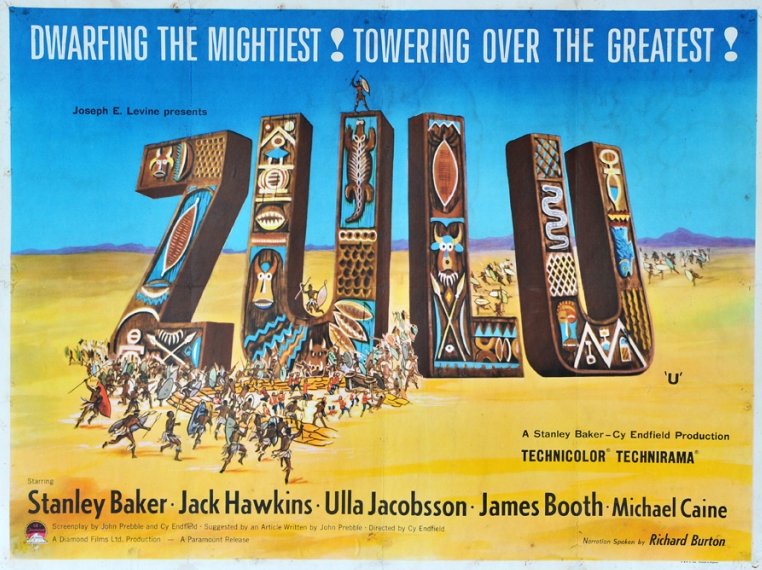
50 years ago (10th July 1964) - Dealing with the siege of a small contingent of British soldiers in South Africa, 'Zulu', starring Michael Caine and Stanley Baker, is showing at the Byron Cinema in Hucknall (source Hucknall Dispatch 11.07.2014) - Synopsis : In January 1879, a communiqué to the government in London, (narrated by Richard Burton), details the crushing defeat of a British force at the hands of the Zulus at the Battle of Isandlwana on January 22, 1879.
At a mass Zulu marriage ceremony witnessed by Boer missionary Otto Witt (Jack Hawkins) and his daughter (Ulla Jacobsson), Zulu King Cetewayo (Chief Mangosuthu Buthelezi) is also informed of the great victory earlier in the day. Witt and his daughter flee from the Zulu village to warn the British soldiers at their mission at Rorke's Drift about an impending Zulu attack.
A company of the British Army's 24th Regiment of Foot, a Welsh regiment, is using the missionary station of Rorke's Drift in Natal as a supply depot and hospital for their invasion force across the border in Zululand. Upon receiving news of Isandhlwana from the Witts and that a large enemy force is advancing their way, Lieutenant John Chard (Stanley Baker) of the Royal Engineers assumes command of the small 135-man British detachment, being senior by virtue of his commission date to Lieutenant Gonville Bromhead (Michael Caine), who, as an infantry officer, is rather put out to find himself subordinate to an engineer. Realising that they cannot outrun the Zulu army, especially with wounded soldiers, Chard decides to fortify the station and make a stand, using wagons, sacks of mealie, and crates of ship's biscuit. When Witt becomes drunk and starts demoralising the men with his dire predictions, causing the soldiers of the Natal Native Contingent to desert, Chard orders him and his daughter to leave. A group of Zulu warriors, on the hills around the fort, see them but recognizing them as missionaries, allow Witt and his daughter to pass by them.
As the Zulu impis approach, a contingent of Boer horsemen arrives. They advise Chard that defending the station is hopeless before they flee, despite Chard's desperate pleas for them to stay. Minutes later, a low rumbling is heard which are thousands of Zulu warriors banging their spears against their cow-hide shields which according to Bromhead "it sounds like a train". The 4,000-strong Zulu impis appears on a ridge overlooking Rorke's Drift and advances to attack.
After an initial assault, hundreds of Zulu riflemen open fire on the station from a neighbouring hill. Over the next few hours, wave after wave of Zulu attackers are repelled. The Zulus do succeed in setting fire to the hospital, leading to intense hand-to-hand fighting between British patients and Zulu warriors as the former try to escape the flames. Malingering Private Henry Hook (James Booth) surprises everyone by taking charge in the successful breakout. Attacks continue into the night.
The next morning, at dawn, the Zulus approach to within several hundred yards and begin singing a war chant; the British respond by singing "Men of Harlech". In the last assault, just as it seems the Zulus will finally overwhelm the tired defenders, the British soldiers fall back to a tiny redoubt that Chard had earlier ordered constructed out of mealie bags. With a reserve of soldiers hidden within the redoubt, they form into three ranks, and pour volley after volley into the stunned natives, who withdraw after sustaining heavy casualties. Later, the Zulus sing a song to honour the bravery of the defenders and leave.
The film ends with a narration by Richard Burton, listing the defenders who received the Victoria Cross, including Private Hook. Eleven were awarded for the actual fighting at Rorke's Drift. (Source matt-282 at IMDB)

50 years ago (5th June 1964) - An entertaining romance and adventure story of the American West, 'McLintock', starring John Wayne and Maureen O'Hara, can be seen at the Byron Cinema in Hucknall (source Hucknall Dispatch 06.06.2014) - Synopsis : George Washington McLintock, "GW" to friends and foes alike, is a cattle baron and the richest man in the territory. He anxiously awaits the return of his daughter Becky who has been away at school for the last two years. He's also surprised to see that his wife Katherine has also returned. She had left him some years before without really explaining what he done but she does make the point of saying that she's returned to take their daughter back to the State Capitol with her. GW is highly respected by everyone around him including the farmers who are pouring into the territories with free grants of land and the Indians who are under threat of being relocated to another reservation. Between his wife, his headstrong daughter, the crooked land agent and the thieving government Indian agent, GW tries to keep the peace and do what is best for everyone. - Written by garykmcd (Source IMDB)
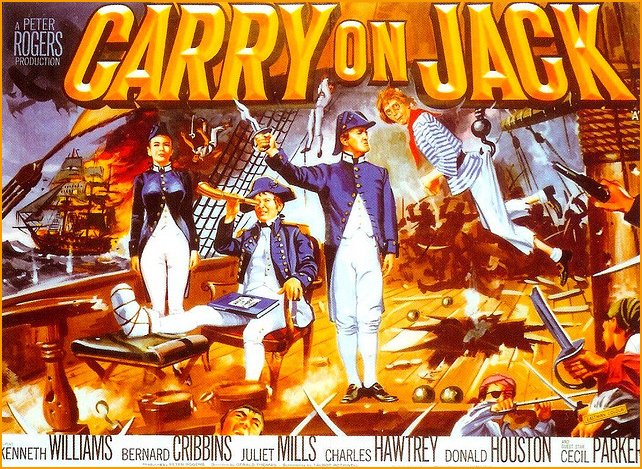
50 years ago (29th May 1964) - British comedy about pirate son the high seas, 'Carry On Jack' is showing at the Byron Cinema in Hucknall (source Hucknall Dispatch 30.05.2014) - Synopsis : The innuendos continue as the Carry On crew takes to the seas in the first of the historical costume parodies tackled by the team. Alas, some regulars are missing, making this one of the less memorable productions in the series. Bernard Cribbins in the lead role doesn't carry the same clout as Sid James at his distastefully smutty best, but longtime Carry On director Gerald Thomas manages to keep the fun shipshape and Bristol fashion, so it's still a must for die-hard fans. Plot Summary : Comedy on the high seas, starring Bernard Cribbins and Kenneth Williams. Naval college graduate Albert Poop-Decker is among the motley crew of the good ship Venus which, under the uncertain guidance of Captain Fearless, sets off for Spanish waters in search of glory. But there are soon mutinous rumblings aboard ship. (Source Radio Times)
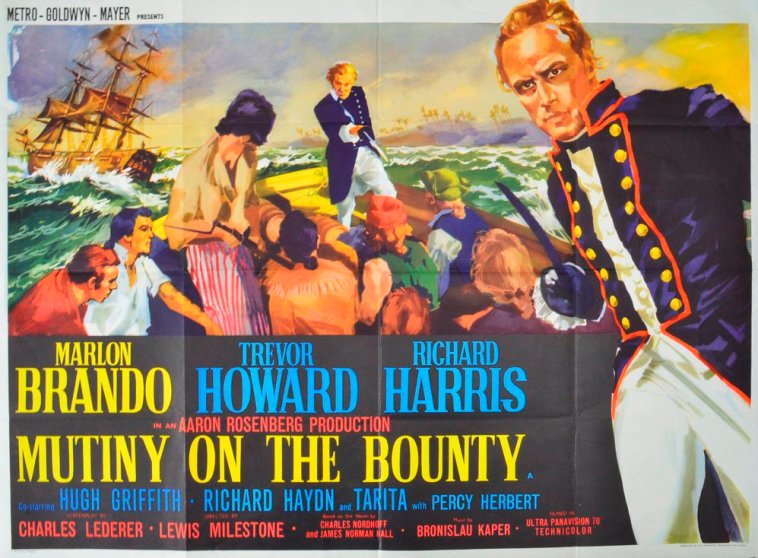
50 years ago (22nd May 1964) - Marlon Brando plays Fletcher Christian and Trevor Howard is Captain Bligh in 'Mutiny on the Bounty', showing at the Byron Cinema in Hucknall (source Hucknall Dispatch 23.05.2014) - Synopsis: Based on a true story: The Bounty, a British sailing ship commanded by Captain Bligh sails for Tahiti to pick up breadfruit plants and take them to Jamaica where they are to be planted and help supply the British with a compact, easy to grow, nutritious plant. Lt. Christian is the executive officer - that is, second in command of the vessel. The ship proceeds south with the intention of rounding Cape of Good Hope, Africa and proceed via the Indian and Pacific Ocean to the Tahitian islands. Captain Bligh is pressed for time since he must get to Tahiti while the plants are transportable. He decides to cut 5 months off the journey by going around Cape Horn (South America) instead. However, he encounters typical horrible weather and is unable to make the transit. He then reverses course (to the east) and goes to Tahiti via the originally intended route. This diversion costs more time and pretty much guarantees he will be late in arriving in Tahiti which will require staying there until the plants are transportable (perhaps 6 months). During all this time, Bligh is abusing his men and officers in various ignoble and demeaning ways. He explains his foul behavior to his exec (Mr. Christian) that fear is the only thing seamen understand and this justifies general cruelty and abuse. The sadistic details are numerous and do not advance the plot except to set the stage for the eventual mutiny. After an idyllic stay in Tahiti (the exec, Mr. Christian, is ordered by Bligh to 'sleep with' the Tahitian chief's daughter to avoid insulting the chief) the ship laden with a thousand plants sets sail for Jamaica. More abuse and cruelty ensues on this leg of the trip - mostly as a result of Bligh restricting water to the crew in order to feed the plants (many would otherwise die, says the onboard gardner).
Finally Mr. Christian snaps and takes command of the ship and sets Bligh and a few seamen adrift midocean in a boat with enough provisions to last a while (they do make it back to England where Bligh is acquitted of wrongdoing in a naval trial but is scolded). Christian, now in command of returns to Tahiti, picks up a few of the native guys and gals and wanders the ocean looking for a good hiding place and discovers Pitcairn Island which is uninhabited and in the middle of nowhere and mislocated on the naval charts. The ship is intentionally destroyed by fire at Pitcairn by three of the crew to prevent Christian from making good on an expressed idea to return to England and vindicate the mutiny. Christian is severely burned in the fire when he rushes on board the ship to try to put the fire out. He dies of his burns while saying goodbye to everyone in his death scene. - source IMDB
50 years ago (15th May 1964) - Telling the unique story of a friendship between a boy and a dolphin 'Flipper' can be seen at the Byron Cinema in Hucknall (source Hucknall Dispatch 16.05.2014) - Synopsis: The Florida Keys have been hit by hard times of late. First, a red plague kills off much of the fish in the area. And second, Hurricane Hazel unexpectedly changes course to hit the Keys. Regardless, the Ricks family - fisherman father Po (short for Porter), wife Martha, their preteen son Sandy, and Sandy's pet pelican Pete - live in all its aspects by the sea, even during these hard times. When Sandy witnesses the accidental spearing of a dolphin, he, on his own, decides to find the dolphin to put it out of its misery. Upon finding the injured dolphin, Sandy, not having the heart to shoot him, decides instead to tow the dolphin home. With some care and love, Sandy and Martha nurse the dolphin back to health. Sandy wants to keep the dolphin, who he's named Flipper, but Po ultimately releases Flipper, who he sees as "the enemy": a creature who is on the hunt for whatever short supply of fish there are around the Keys. But Po learns that friends - what Flipper and Sandy are to each other - help each other unconditionally. - Written by Huggo and seen on the IMDB
50 years ago (8th May 1964) - Paul Newman is a young novelist who walks into murderous danger when he goes to Sweden to receive a Nobel Prize award in 'The Prize', showing at the Byron Cinema in Hucknall (source Hucknall Dispatch 09.05.2014) - Synopsis: Newly arrived in Stockholm to receive their Nobel prizes are American novelist Andrew Craig (literature), refugee Max Stratman (physics), John Garrett and Carlo Farelli (medicine), and a French couple, Claude and Denise Marceau (chemistry). Communist agents kidnap Stratman, enlisting the aid of his niece, Emily, on the pretense that the man whom they will put in Stratman's place is her father, the scientist's identical twin, whom she believed dead. The Communists plan to take the real Stratman behind the Iron Curtain, leaving the impostor behind to denounce the United States in his acceptance speech. The frustrated, alcoholic Craig, whose professed interest in the prize is purely financial, proclaims at a press conference that he no longer writes serious literature but produces only detective stories; and he promptly improvises a story about the kidnaping of a Nobel Prize winner. Having known Stratman, Craig soon becomes suspicious of the impostor; starts his own investigation; and finds himself at the center of an intrigue. Though several attempts are made upon Craig's life, the police and Inger Lisa Andersen, a pretty Swedish official assigned to keep him out of trouble, refuse to believe his story; but eventually he convinces Inger that Stratman is being smuggled out of the country. Almost singlehanded he rescues Stratman from a freighter and brings him back to his hotel. Exhausted by his experience, the old man suffers a heart attack but is revived by Garrett and Farelli, who had previously been enemies. When Stratman makes his appearance at the Nobel ceremonies, his brother flees from the scene and is mistakenly killed by a Communist. It is then revealed that the impersonator was a professional actor, the twin having died years before in Russia. With a changed attitude, Craig then accepts the award and begins a romance with Inger. Source - Turner Classic Movies
50 years ago (17th or 24th April 1964) - 'The Yellow Teddy Bears', showing at the Byron Cinema in Hucknall, stars Annette Whitely as a 16-year-old schoolgirl who runs away to London after becoming pregnant (source Hucknall Dispatch 18 and 25.04.2014) - Also known as 'The Gutter Girls' - bit of a sizzler, apparently this film - a critique is offered here. Plot Summary: A clique of girls in an English school wear a small yellow teddy bear on their uniform to signify that they have lost their virginity. Linda, the girl's leader, fears she may be pregnant from her window cleaner boyfriend, "Kinky", an aspiring pop singer. Desperate, and unable to confide in her parents, she must wrestle with her conscience and decide what course of action to take. Meanwhile, a concerned teacher learns the significance of the yellow teddy bears, and in trying to help the girls in question, puts her own career in jeopardy. Source : IMDB
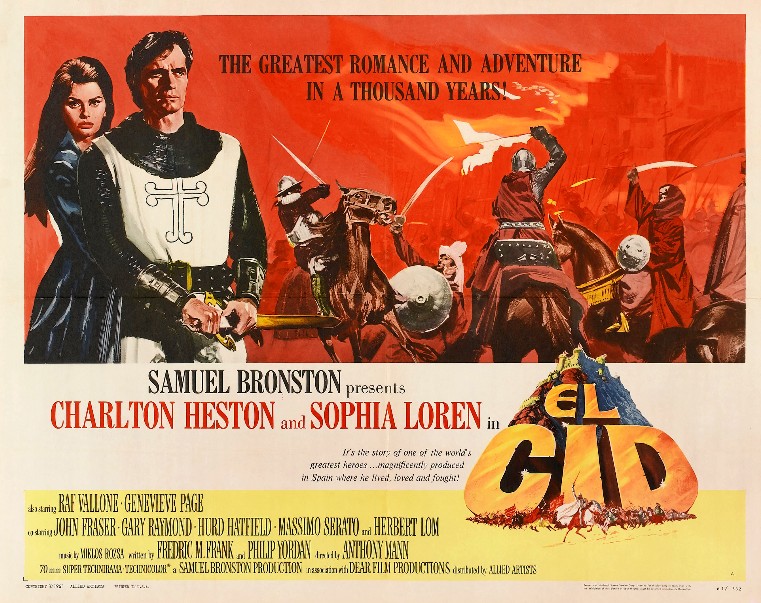
50 years ago (10th April 1964) - A spectacular historical epic, set in Spain, 'El Cid' is showing at the Byron Cinema in Hucknall, co-starring Charlton Heston and Sophia Loren (source Hucknall Dispatch 11.04.2014). Synopsis: In 11th-century Spain, the Christian kingdoms of Castile, Leon, and Aragon face the constant threat of the warring Moors and their determination to spread the Islamic culture throughout all of Europe. Into this arena of violence rides Rodrigo Diaz de Vivar, whose courage, wisdom, and spiritual strength earn him the sobriquet El Cid, or "The Lord." Following one particular battle, El Cid liberates some Moorish emirs on their vow never again to attack Castile. His act of mercy is misinterpreted as treason by Count Gormaz, the father of his beloved Chimene, and to protect the family honor El Cid is forced to slay the Count in a duel. Although Chimene vows to have her revenge, she is obliged to marry El Cid upon the bidding of King Ferdinand, but they do not consummate the marriage, and Chimene enters a convent. A short time later Ferdinand dies, and his kingdom is divided amongst his three quarrelsome children, Alfonso, Sancho, and Urraca. Before long, the weak, ambitious Alfonso arranges the assassination of Sancho. When El Cid refuses to vow allegiance unless Alfonso swears himself innocent of his brother's death, he is banished from Castile. But through the long years that follow, El Cid continues to battle the Moors, and his ranks increase as loyal subjects join him by the score. Eventually his noble nature wins over even Chimene, and she again declares her love for him. When the Moorish leader, Ben Yussuf, begins planning a massive invasion of Valencia, Alfonso recalls El Cid from exile and places him in charge of the army. For days the battle rages and on the eve of the last great Moorish onslaught El Cid is mortally wounded by a stray arrow. Attended by Chimene, he makes her promise that, alive or dead, he will lead the next day's charge. Obedient to her husband's wishes, Chimene has El Cid's dead body mounted firmly on his white charger and placed before his troops. And when the Moors see the seemingly invincible El Cid riding once more into battle, terror and confusion overtake them, and they flee in disorganized panic toward their ships. Source - Turner Classic Movies
50 years ago (13th or 20th March 1964) - Bubbly Doris Day stars in a romantic comedy, 'The Thrill of it All', showing at the Byron Cinema in Hucknall (sources Hucknall Dispatch 14 and 21.03.2014 - both editions are identical in the 'Backtracking' article). Synopsis: Beverly Boyer is a thrifty housewife living contentedly with her gynaecologist husband, Gerald, and their two small children. One evening while dining at the home of Mrs. Evelyn Fraleigh, one of Gerald's patients, Beverly comments on the fine qualities of "Happy Soap," a product manufactured by Evelyn's father-in-law, Tom Fraleigh. The old man is so impressed by Beverly's enthusiasm that he hires her to do soap commercials on his television show. After an unfortunate start, Beverly's honesty and sincerity wins praise from both viewers and critics. Elated, old Fraleigh signs her to an $80,000 contract. Now a public celebrity, Beverly is forced to spend more and more time away from home; and trouble erupts at the Boyer household. The final blowup comes when Gerald accidentally drives his car into a swimming pool that had been installed in his backyard that afternoon. Outraged, he kicks cartons of "Happy Soap" into the pool and by morning the house is surrounded by soapsuds. After consulting a psychiatrist, he decides to get even with Beverly by pretending also to be too busy to spend time at home. His scheme works, and Beverly becomes so frantic that she forgets the name of the soap she advertises. The couple are reunited in the back seat of the Fraleighs' Rolls-Royce, and there Gerald delivers Evelyn's baby during a traffic jam. Beverly decides to quit her job and return to her role as wife and mother. Source - Turner Classic Movies
An accident in the butchers shop leads Norman and Mr Grimsdale to the hospital where, after causing the normal amount of chaos, Norman finds Lindy, a little girl who hasn't spoken or smiled since her parents were killed in an aeroplane accident. Norman decides to help. (Source IMDB)
50 years ago (27th March 1964) - A Norman Wisdom comedy, 'A Stitch in Time', and a rip-roaring Western, 'Rio Bravo', starring John Wayne, can be seen at the Byron Cinema in Hucknall (source Hucknall Dispatch 28.03.2014) - Nothing if not a diverse choice for a diverse audience. "Set in Texas during the late 1860s, Rio Bravo is a story of men (and women) and a town under siege. Presidio County Sheriff John T. Chance (John Wayne) is holding Joe Burdette (Claude Akins), a worthless, drunken thug, for the murder of an unarmed man in a fight in a saloon -- the problem is that Joe is the brother of wealthy land baron Nathan Burdette (John Russell), who owns a big chunk of the county and can buy all the hired guns he doesn't already have working for him. Burdette's men cut the town off to prevent Chance from getting Joe into more secure surroundings, and then the hired guns come in, waiting around for their chance to break him out of jail. Chance has to wait for the United States marshal to show up, in six days, his only help from Stumpy (Walter Brennan), a toothless, cantankerous old deputy with a bad leg who guards the jail, and Dude (Dean Martin), his former deputy, who's spent the last two years stumbling around in a drunken stupor over a woman that left him. Chance's friend, trail boss Pat Wheeler (Ward Bond), arrives at the outset of the siege and tries to help, offering the services of himself and his drovers as deputies, which Chance turns down, saying they're not professionals and would be too worried about their families to be good at anything except being targets for Burdette's men; but Chance does try to enlist the services of Wheeler's newest employee, a callow-looking young gunman named Colorado Ryan (Ricky Nelson), who politely turns him down, saying he prefers to mind his own business. In the midst of all of this tension, Feathers (Angie Dickinson), a dance hall entertainer, arrives in town and nearly gets locked up by Chance for cheating at cards, until he finds out that he was wrong and that she's not guilty -- this starts a verbal duel between the two of them that grows more sexually intense as the movie progresses and she finds herself in the middle of Chance's fight. Wheeler is murdered by one of Burgette's hired guns who is, in turn, killed by Dude in an intense confrontation in a saloon. Colorado throws in with Chance after his boss is killed and picks up some of the slack left by Dude, who isn't quite over his need for a drink or the shakes that come with trying to stop. Chance and Burdette keep raising the ante on each other, Chance, Dude, and Colorado killing enough of the rancher's men that he's got to double what he's paying to make it worth the risk, and the undertaker (Joseph Shimada) gets plenty of business from Burdette before the two sides arrive at a stalemate -- Burdette is holding Dude and will release him in exchange for Joe. This leads to the final, bloody confrontation between Chance and Burdette, where the wagons brought to town by the murdered Wheeler play an unexpected and essential role in tipping the balance."~ Bruce Eder, All Movie Guide
50 years ago (6th March 1964) - All about a group of people stranded at a fog-bound airport. 'The VIPs' co-starring Elizabeth Taylor and Richard Burton, is showing at the Byron Cinema in Hucknall. (Source Hucknall Dispatch 07.03.2014) - "Fog delays a group of travellers headed for New York. They wait at the V.I.P. lounge of London Airport, each at a moment of crisis in his or her life." IMDB Ref - considering the other stars of this film, amongst them our own Maggie Smith as Burton's lovesick secretary, Louis Jourdan doing what Louis Jourdan does best, larger than life Orson Welles and Rod Taylor (the Time Machine - see below) this would today, be known as a blockbuster and one name that should never be omitted if she is in a cast list, is the redoubtable and national treasure - Margaret Rutherford!
50 years ago (28th February 1964) - Greek mythology is brought vividly to life in 'Jason and the Argonauts', showing at the Byron Cinema in Hucknall (source Hucknall Dispatch 28.02.2014)
50 years ago (21st February 1964) - The classic, Alfred Hitchcock suspense thriller, 'The Birds', is showing at Hucknall's Byron Cinema (source Hucknall Dispatch 21.02.2014)
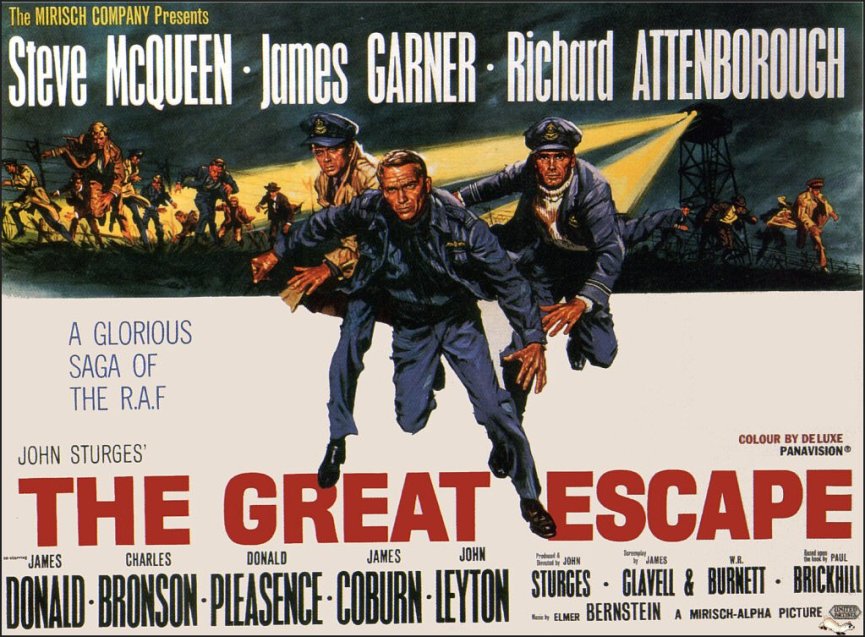
50 years ago (14th February 1964) - The film that made Steve McQueen a superstar. 'The Great Escape', can be seen at the Byron Cinema in Hucknall. Meanwhile, Big Bonus Bingo continues at the Byron, with an admission price of 2/- (two shillings) and 1/6d (one and sixpence) for pensioners. (Source Hucknall Dispatch 14.02.2014). 'The Great Escape is based on the true story of a group of Allied prisoners of war who managed to escape from an allegedly impenetrable Nazi prison camp during World War II. At the beginning of the film, the Nazis gather all their most devious and troublesome POWs and place them at a new prison camp, which was designed to be impervious to escapes. Immediately, the prisoners develop a scheme where they will leave the camp by building three separate escape tunnels. Richard Attenborough is the British soldier who masterminds the whole plan, and who commands his motley squad. featuring Charles Bronson as a Polish trench-digging expert, James Garner as an American with a talent for theft, Donald Pleasence as a masterful forger, and Steve McQueen as an American rebel, through the construction of the tunnels and, eventually, their escape. An epic adventure film, The Great Escape runs nearly three hours, featuring a rousing Elmer Bernstein score and exciting action sequences, including a notorious motorcycle chase between McQueen and the Nazis -- the likes of which had never been seen before in Hollywood productions.' ~ Stephen Thomas Erlewine, All Movie Guide
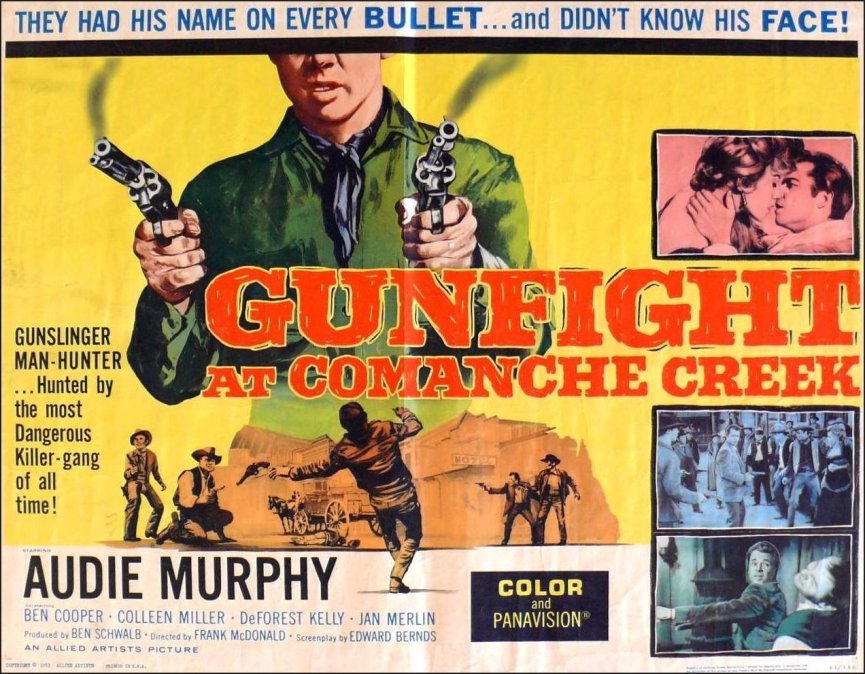
50 years ago (7th February 1964) Audie Murphy stars in 'Gunfight at Comanche Creek', showing at Hucknall's Byron Cinema. As the title implies, it is a lively Western (thank you to the Hucknall Dispatch for the dialogue). I see DeForest Kelly (much love 'Bones' in the original Star Trek) stars in this (possibly) little known Western. From TCM (Turner Classic Movies) : "Bob Gifford of the National Detective Agency is assigned to smash a Colorado outlaw gang that operates by breaking wanted men out of jail, forcing them to be the unmasked front men in their holdups, and when the price on their heads grows high, killing them and claiming the reward money. In an effort to learn the identity of the gang's secret leader, Gifford poses as a criminal and is taken into the gang through the usual process and forced to participate in their crimes. Meanwhile, he becomes attracted to Abbie, the owner of the town's hotel-saloon. Another agent, Nielson, is assigned to follow and assist Gifford, but the outlaws eventually discover his camp, and he sacrifices himself to avoid compromising his partner. Carter, a young outlaw who wants to quit the gang and settle down, befriends Gifford and sets out to inform the local marshal of the group's activities. He fails to return, however, and Gifford realizes that the marshal himself is the leader of the gang. As Gifford is about to be killed for the reward, other National Detective Agency men come to his rescue, and, after a raging gun battle, the marshal is arrested."
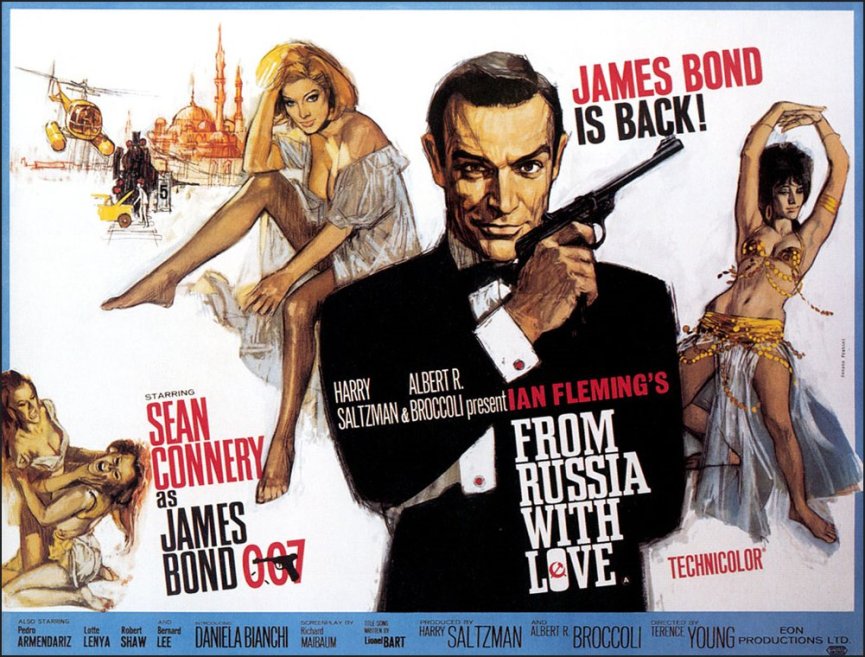
50 years ago (31st January 1964) Sean Connery is British Secret Service agent James Bond, alias 007, in 'From Russia With Love', showing at the Byron Cinema in Hucknall. "Broccoli considered this as one of the best Fleming stories. Connery once again excelled and was well supported by a great cast including Robert Shaw, wonderfully menacing as a brutal killer; and Lotte Lenya as the Russian agent with the famous poison-tipped knife device in her shoe. The film also features many distinctive Bond motifs for the first time and its huge success firmly established the 007 films as a cultural phenomenon." (Google)
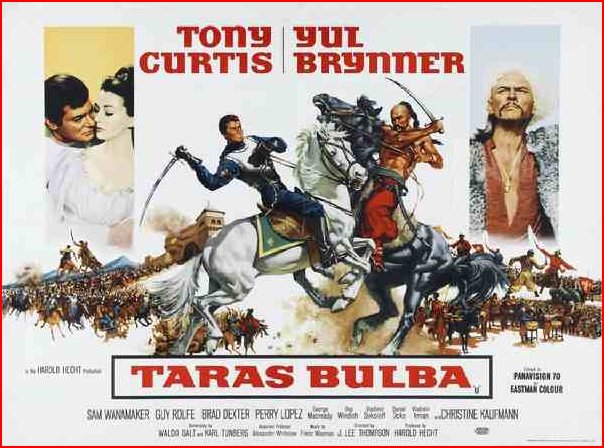
50 years ago (17th and 24th January 1964) Yul Brynner in the title role of a 'Cossack Chieftain' and Tony Curtis, the decades hearthrob as his son were paired in the blockbuster 'Taras Bulba' filmed in Panavision and Eastmancolor. IMDB gives the following summary: "The Cossacks of Eastern Europe join the Poles to rid the Turks from the Steps of Europe. In return for their aid, the Poles agree to give control of the Steps to the Cossacks. After the battle, however, the Poles back out of their agreement and force the Cossacks into the hills. Taras Bulba, a Cossack Colonel, raises his son, Andrei Bulba to learn the ways of the Poles so he can one day defeat them in battle. In his learning process, however, Andrei falls in love with the daughter of a Polish Nobleman. This twist causes Andrei Bulba to choose between the love of the Cossacks, and the love of a woman, and causes Taras Bulba to choose between the love of his son, and the love of the Cossacks."
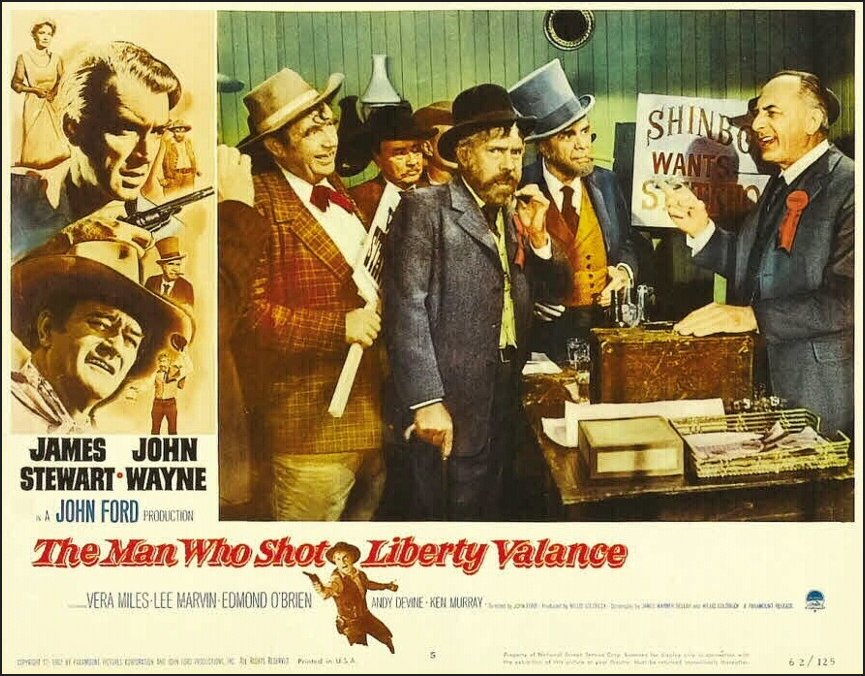
50 years ago (17th January 1964) John Wayne, James Stewart and Lee Marvin co-star in the classic Western, 'The Man Who Shot Liberty Valance' showing at the Byron Cinema in Hucknall (thank you again to the Hucknall Dispatch) for updating the historical record. As usual the Byron was right up there with the popular choice! From the All Movie Guide : "Like Pontius Pilate, director John Ford asks What is truth? in The Man Who Shot Liberty Valanc, but unlike Pilate, Ford waits for an answer. The film opens in 1910, with distinguished and influential U.S. senator Ransom Stoddard (James Stewart) and his wife Hallie (Vera Miles) returning to the dusty little frontier town where they met and married twenty-five years earlier. They have come back to attend the funeral of impoverished nobody Tom Doniphon (John Wayne). When a reporter asks why, Stoddard relates a film-long flashback. He recalls how, as a greenhorn lawyer, he had run afoul of notorious gunman Liberty Valance (Lee Marvin), who worked for a powerful cartel which had the territory in its clutches. Time and again, pilgrim Stoddard had his hide saved by the much-feared but essentially decent Doniphon. It wasn't that Doniphon was particularly fond of Stoddard; it was simply that Hallie was in love with Stoddard, and Doniphon was in love with Hallie and would do anything to assure her happiness, even if it meant giving her up to a greenhorn. When Liberty Valance challenged Stoddard to a showdown, everyone in town was certain that the greenhorn didn't stand a chance. Still, when the smoke cleared, Stoddard was still standing, and Liberty Valance lay dead. On the strength of his reputation as the man who shot Valance, Stoddard was railroaded into a political career, in the hope that he'd rid the territory of corruption. Stoddard balked at the notion of winning an election simply because he killed a man-until Doniphon, in strictest confidence, told Stoddard the truth: It was Doniphon, not Stoddard, who shot down Valance. Stoddard was about to reveal this to the world, but Doniphon told him not to. It was far more important in Doniphon's eyes that a decent, honest man like Stoddard become a major political figure; Stoddard represented the new civilized west, while Doniphon knew that he and the West he represented were already anachronisms. Thus Stoddard went on to a spectacular political career, bringing extensive reforms to the state, while Doniphon faded into the woodwork. His story finished, the aged Stoddard asks the reporter if he plans to print the truth. The reporter responds by tearing up his notes. This is the West, sir, the reporter explains quietly. When the legend becomes fact, print the legend. Dismissed as just another cowboy opus at the time of its release, The Man Who Shot Liberty Valance has since taken its proper place as one of the great Western classics. It questions the role of myth in forging the legends of the West, while setting this theme in the elegiac atmosphere of the West itself, set off by the aging Stewart and Wayne."~ Hal Erickson, All Movie Guide
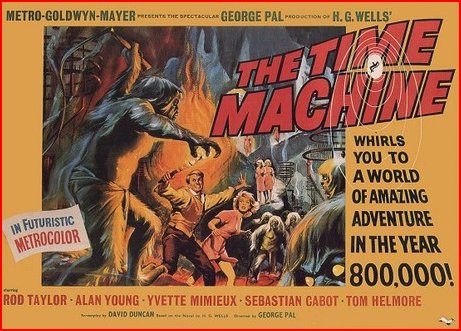
50 years ago (6th December 1963) "Based on a novel by H.G. Wells, 'The Time Machine' - a forerunner of Dr Who's TARDIS' - is showing at the BYRON CINEMA in Hucknall, starring Rod Taylor." Thank you to the Hucknall Dispatch for this historical snapshot. The film poster boasts 'In Futuristic Metrocolor' and there is already evidence that the Byron prides itself in using the best and latest technology. Another image reminds us that the film is not suitable for children.
The Byron Redeemed
2018
Good to see the Byron Cinema used as a backdrop for the 'Ashfield Police' Fb page
2014 - Ashfield District Council Hucknall tourism signage
The Remit :
Skills Needed: Design, artwork, retouching, illustration, photography
Client: Ashfield District Council
Close up detail of Byron Cinema from Hucknall tourism panel - image sourced from, courtesy & © of monkie.co.uk (I really love this simplified icon)
Hucknall market place tourism sign for Ashfield District Council - image sourced from, courtesy & © of monkie.co.uk
Ashfield District Council Hucknall tourism panel - image sourced from, courtesy & © of monkie.co.uk
Close up map detail from Hucknall tourism panel - image sourced from, courtesy & © of monkie.co.uk
"An historic market town within the former coalfields of north Nottinghamshire, Hucknall has a rich heritage and was the birth or resting place of many famous, historical figures. Ashfield District Council required a refresh of the town's tourism signage and Monkie produced an updated solution with new mapping and imagery. Highlighted stories include poet Lord Byron, mathematician Ada Lovelace, composer Eric Coates, the long-gone mining and framework knitting industries, and its historic church which features a small visitor centre incorporating many of the featured themes. Interpretation panels at five sites, lead visitors from the local public transport hub, through the town, to its central market place. Along the way, fascinating stories reveal the true significance the town plays in Nottinghamshire history." Source : monkie.co.uk
March 2014 - UNWELCOME PUBLICITY FOR THE BYRON CINEMA

Image courtesy of the British Broadcasting Corporation
"A man has been arrested after a 10-hour armed siege at a snooker hall in Nottinghamshire.
Police spent hours negotiating with the man at the Spot On Snooker Club in Hucknall, before entering at about 00:40 GMT and arresting him. Two women who were thought to be hiding in the club had emerged unharmed after about seven hours. A 20-year-old was detained on suspicion of possessing a firearm with intent to cause fear of violence, police said. He was being questioned in custody, they added. Officers had first been called to the building in Vine Street at about 14:40 GMT over reports of a man said to be "acting suspiciously". A man claiming to be the gunman told reporters who called the club during the siege: "It's none of your business why I'm here." Answering the phone to the Nottingham Post, the man said "I'm the guy with the gun. "I'm not sure what happened. I'm on my own in here, everyone else just ran off. I'm going to go home in a minute and chill out and watch TV and that."
'Extremely distressed' By 22:00 GMT police said they were "in direct negotiations" with the man inside the club. They said the two women who escaped were "extremely distressed but uninjured" and had "been guided to safety". Vine Street was closed off and children at nearby Beardall Street Primary School were sent home with a police escort, while people were at one point told not to leave the nearby Byron Cinema because it was not safe. Ria Cash, who was trapped inside the cinema, said: "It was exciting to start with but it is getting quite stressful in here now. "We have seen armed police, several vans and ambulances coming through and there's got to be about 30 to 40 police around." After the arrest Nottinghamshire Police said Vine Terrace and High Street would be reopened and residents allowed to return home but a cordon would remain at the snooker hall while officers examined the scene. Residents unable to get to their homes were earlier told by the force to find temporary accommodation or go to Hucknall Leisure Centre."
As can be seen from the BBC website narrative, direct involvement with the Byron Community Project was the presence of the Chair, Ria Cash, being trapped inside the cinema as the police cordon created a siege situation in the town centre.
28TH JANUARY 2011 - CLOSURE ANNOUNCEMENT
The Byron Cinema stars in THE BYRON CINEMA
When using Hucknall as a film location it is difficult not to include the Byron Cinema - this section will explore how the Byron Cinema has been the leading lady not just a mechanism to project moving images (and not forgetting sound!) in film and on television!
2009
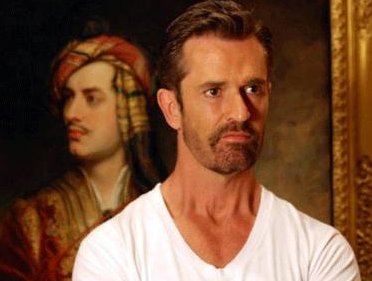 Hucknall bingo hall welcomes Hollywood star Rupert Everett for a numbers game session.
Hucknall bingo hall welcomes Hollywood star Rupert Everett for a numbers game session.
Rupert Everett took part in a numbers game session at the Byron Bingo Club in Hucknall while filming his recent documentary on Lord Byron. The Nottinghamshire town is the final resting place of the great Romantic poet and therefore featured in Channel 4's The Scandalous Adventures of Lord Byron, in which Everett retraced the literary icon's famous journey around Europe. After visiting Byron's former haunts in Lisbon, Istanbul and Albania, the actor travelled to Hucknall and enjoyed a few games of bingo with local people while discussing the poet's life. A review in the Hucknall Dispatch noted that this section of the programme "could not have been a bigger contrast to visits Everett made to palatial and cultural buildings in different parts of Europe as he followed in Byron's footsteps". Byron was buried in the parish church at Hucknall after his death in Greece in 1824. As one of Britain's foremost poets of the Romantic movement, he is remembered for his decadent and frequently chaotic lifestyle, as well as poems such as She Walks in Beauty, Childe Harold's Pilgrimage and Don Juan. Ref: 777.com
Ref: 777.com
Rupert Everett plays Bingo with Fans at Hucknall Bingo Hall
Taking a break from the filming of his controversial documentary on the life of poet Lord Byron, British actor Rupert Everett joined a group of bingo players for an evening of fun gaming at the local Hucknall bingo hall. Hucknall in Nottinghamshire is where the great poet has been laid to rest and Rupert’s documentary featuring on Channel 4 titled “The Scandalous Adventures of Lord Byron” has evinced considerable public interest and criticism. Mr. Everett took part in several rounds of bingo whilst discussing the life of Byron with the assembled motley group in the bingo hall. Lord Byron travelled across Europe and Mr. Everett, in an attempt to understand the finer nuances of the late poet’s life, has practically toured most of the continent including places like Lisbon, Albania and Turkey which were among the poet’s favorite haunts. As contrasted to these trans-European visits, his visit to the Hucknall bingo hall was completely different. In fact, the Hucknall Dispatch was quoted as saying the next day, “this section of the program could not have been a bigger contrast to visits Everett made to palatial and cultural buildings in different parts of Europe as he followed in Byron’s footsteps.” Byron’s final resting place, post his demise in 1824 in Greece, is at a Parish church in Hucknall.
The hall has also been named after the great poet, often hailed as one of the biggest voices of the Romantic Movement in the UK during late 18th century and the early part of the 19th century. Byron has written many memorable sonnets including Don Juan, She Walks In Beauty and Childe Harold’s Pilgrimage. Footage from Everett’s bingo outing in Byron Bingo is included in the Channel 4 documentary. During the bingo games Everett spoke at length about the life of Byron. He also seemed to enjoy a good vibe with the local players who were largely women. When one of them was approached for a comment on Lord Byron, she replied, “He was a bit of a lad, wasn’t he?” The two part documentary series is concluded by Everett with a trip to Lake Geneva and Greece where Byron contracted fever and died. Although the documentary does not include actual footage of his burial place, shots of a small shop in Yorke Street called Byron carpets is included. The bingo footage comes after this shot. The documentary has faced some bit of criticism with ardent Byron followers dismissing it as ‘factually inaccurate.’ ref: Britain.Bingo
The good people of Hucknall, Nottingham were in for a pleasant surprise. Hollywood celebrity, Rupert Everett, attended a bingo session at the Byron Bingo Club in Hucknall recently while filming a documentary on Lord Byron. After visiting Lord Byron’s favourite haunts such as Lisbon, Albania and Turkey, Everett came back to the UK and visited Hucknall, where the Romantic poet is buried. Filming for Channel 4, the documentary, titled The Scandalous Adventures of Lord Byron, traces the poet’s life and his journey’s across Europe.
While visiting Hucknall, Everett played bingo with the local residents in the Byron Bingo Club and discussed the poet’s life. This was such a stark contrast to Everett’s previous visits in Europe while filming the documentary that a review in Hucknall Dispatch said “this section of the programme could not have been a bigger contrast to visits Everett made to palatial and cultural buildings in different parts of Europe as he followed in Byron's footsteps". Byron died in Greece in 1824, but was buried in the parish church in Hucknall. As a famous proponent of the Romantic Movement in the UK, he is known not just for his amazing poetry, but also for his tumultuous life, his many affairs, scandals and his life abroad. Some of his better known sonnets are She Walks in Beauty, Childe Harold's Pilgrimage and Don Juan. Though the documentary shot footage of the grave and the parish church, it was not actually shown in the final cut when aired on television. What was shown instead was a shot of a shop front in Yorke Street called Byron Carpets. This was followed by footage of Rupert Everett’s visit to Byron Bingo where he joined the locals for a bingo game at the hall. Everett seemed to get along with the local women marvellously; everyone seemed to be having a good time. When one of local women was asked to comment on Lord Byron, she noted "He was a bit of a lad, wasn't he?" Ref: mybingostreet
From the Hucknall Dispatch (4th August 2009):
Actor Rupert Everett mingles with bingo players at Byron
REVIEW OF THE TV PROGRAMME – 'The Scandalous Adventures Of Lord Byron' (part two), Channel 4.
Many Hucknall people would have watched the second part of this controversial documentary until the end to see if their town got a mention. Well, the programme makers did come to Hucknall but the parish church, where Byron is buried, was surprisingly not featured. Instead there was a shot of the Byron Carpets sign on Yorke Street and this was followed by Hollywood actor Rupert Everett, who presented the programme, joining in a session at the Byron Bingo Hall. In a hilarious, sometimes ribald, conversation with women patrons, one of them was asked about the illustrious poet and commented: "He was a bit of a lad, wasn't he?"
This part of the programme could not have been a bigger contrast to visits which Everett made to palatial and cultural buildings in different parts of Europe as he followed in Byron's footsteps. The documentary ended where it had started – outside Byron's grand ancestral home, Newstead Abbey. The programme certainly lived up to its title by depicting the scandalous side of Byron's life, for which there was no lack of evidence. But perhaps unexpectedly, Everett ultimately focused on Byron's frailties, particularly his declining health at the end of his life, and concluded that this factor was what endeared him most to the poet.
And controversially from 18th September 2009
Woman defended Byron to Hollywood A-lister
Updated on 18th September 2009 13:47 Published 10/09/2009 17:44
The bingo-player from Hucknall who memorably rebuked Hollywood actor Rupert Everett for being rude has now come forward. Carmen Broughton (50), of Salterford Road, has been praised for putting Everett in his place when he visited the Byron Bingo Hall on Hucknall High Street while filming the controversial Channel 4 TV programme, 'The Scandalous Adventures Of Lord Byron'. Newstead Abbey Byron Society wanted to contact Carmen through the Dispatch and are planning to give her a reward.
Carmen did not hesitate to tell Everett off when he kept asking women bingo players smutty questions about Byron's sexual attributes. "His language was totally uncalled for," said Carmen, a mother-of-three. "You can't speak to people like that. It's not funny."
Page refreshed : 16th June 2020 (G)
